Symbol Technologies PDT8138 1900 MHz CDMA Packet PC User Manual PCS Card AC550 OG
Symbol Technologies Inc 1900 MHz CDMA Packet PC PCS Card AC550 OG
Contents
- 1. Pocket PC user manual
- 2. CDMA user manual
CDMA user manual

User’s Guide
PCS Connection CardTM
by Sierra Wireless
AirCard® 550
Copyright © 2002 Sprint Spectrum L.P. All rights reserved. No reproduction in whole or in part
allowed without prior written approval. Sprint, the diamond logo and all other trademarks listed
herein are registered trade marks of Sprint Communications Company, L.P., used under license.
Table of Contents
Welcome to Sprint . . . . . . . . . . . . . . . . . . . . . . . . . . . . . . . . . . . i
Introduction to this User’s Guide. . . . . . . . . . . . . . . . . . . . . . iii
SECTION 1: PCS Connection Card Basics . . . . . . . . . . . . . . . 1
1A.Introducing the
PCS Connection CardTM . . . . . . . . . . . . . . . . . . . . . . . . . . . . . . . . . . . . . . . . . 3
Your PCS Connection Card. . . . . . . . . . . . . . . . . . . . . . . . . . . . . . . . . . . 4
CDMA Networks . . . . . . . . . . . . . . . . . . . . . . . . . . . . . . . . . . . . . . . . . . 4
A Network Card and a Phone . . . . . . . . . . . . . . . . . . . . . . . . . . . . . . . . . 5
Package Contents . . . . . . . . . . . . . . . . . . . . . . . . . . . . . . . . . . . . . . . . . . 5
About This Guide . . . . . . . . . . . . . . . . . . . . . . . . . . . . . . . . . . . . . . . . . . 6
1B.Getting StartedWith Your
PCS Connection CardTM . . . . . . . . . . . . . . . . . . . . . . . . . . . . . . . . . . . . . . . . . 7
Getting Started . . . . . . . . . . . . . . . . . . . . . . . . . . . . . . . . . . . . . . . . . . . . 8
The PCS Connection Card Software. . . . . . . . . . . . . . . . . . . . . . . . . . . . 8
Activating and Using PCS Service . . . . . . . . . . . . . . . . . . . . . . . . . . . . . . 8
Care and Maintenance . . . . . . . . . . . . . . . . . . . . . . . . . . . . . . . . . . . . . 10
SECTION 2: Installing the
PCS Connection Card. . . . . . . . . . . . . . . . . . . . . . . . . . . . . . . . 11
2A.Installation on Notebook PCs . . . . . . . . . . . . . . . . . . . . . . . . . . . . . . . . 13
Getting Started . . . . . . . . . . . . . . . . . . . . . . . . . . . . . . . . . . . . . . . . . . . 14
System Requirements. . . . . . . . . . . . . . . . . . . . . . . . . . . . . . . . . . . . . 14
Installing the PCS Connection ManagerSM Software (Windows 98 SE, Me,
and 2000). . . . . . . . . . . . . . . . . . . . . . . . . . . . . . . . . . . . . . . . . . . . . . . . 15
Installing the PCS Connection Manager Software (Windows XP). . . . 17
Inserting and Removing the PCS Connection Card . . . . . . . . . . . . . . . 19
Activating Your PCS Connection Card . . . . . . . . . . . . . . . . . . . . . . . . . 20
2B.Installation on Handheld and Pocket PCs . . . . . . . . . . . . . . . . . . . . . . 23
Getting Started . . . . . . . . . . . . . . . . . . . . . . . . . . . . . . . . . . . . . . . . . . . 24
System Requirements. . . . . . . . . . . . . . . . . . . . . . . . . . . . . . . . . . . . . 24
Installing the PCS Connection ManagerSM Software . . . . . . . . . . . . . 26
Inserting and Removing the PCS Connection Card . . . . . . . . . . . . . . . 28
Activating Your PCS Connection Card . . . . . . . . . . . . . . . . . . . . . . . . . 29
SECTION 3: Using the
PCS Connection Card. . . . . . . . . . . . . . . . . . . . . . . . . . . . . . . . 33
3A.The PCS Connection ManagerSM Window and Indicators . . . . . . . 35
The PCS Connection Manager . . . . . . . . . . . . . . . . . . . . . . . . . . . . . . . 36
Starting the PCS Connection Manager Software . . . . . . . . . . . . . . . . . 36
Getting Help . . . . . . . . . . . . . . . . . . . . . . . . . . . . . . . . . . . . . . . . . . . . . 37
The PCS Connection Manager Window . . . . . . . . . . . . . . . . . . . . . . . . 37
Displaying the Menu Items . . . . . . . . . . . . . . . . . . . . . . . . . . . . . . . . 39
Keypad Button (Notebook / Handheld PCs) . . . . . . . . . . . . . . . . . . . 39
The Minimize and Close Buttons (Notebook / Handheld PC) . . . . 39
Message Area . . . . . . . . . . . . . . . . . . . . . . . . . . . . . . . . . . . . . . . . . . . 40
Indicator Area . . . . . . . . . . . . . . . . . . . . . . . . . . . . . . . . . . . . . . . . . . . 42
GO Button . . . . . . . . . . . . . . . . . . . . . . . . . . . . . . . . . . . . . . . . . . . . . 46
Taskbar Icons. . . . . . . . . . . . . . . . . . . . . . . . . . . . . . . . . . . . . . . . . . . . . 46
3B.Data Connections . . . . . . . . . . . . . . . . . . . . . . . . . . . . . . . . . . . . . . . . . . . 49
The Basics . . . . . . . . . . . . . . . . . . . . . . . . . . . . . . . . . . . . . . . . . . . . . . . 50
PCS Vision (High-Speed) Connections. . . . . . . . . . . . . . . . . . . . . . . . . 51
Dormant Connection . . . . . . . . . . . . . . . . . . . . . . . . . . . . . . . . . . . . . 52
3C. Voice Connections . . . . . . . . . . . . . . . . . . . . . . . . . . . . . . . . . . . . . . . . . . 53
Voice Connection Features. . . . . . . . . . . . . . . . . . . . . . . . . . . . . . . . . . 54
Using the Keypad. . . . . . . . . . . . . . . . . . . . . . . . . . . . . . . . . . . . . . . . . . 55
Outgoing Calls. . . . . . . . . . . . . . . . . . . . . . . . . . . . . . . . . . . . . . . . . . . . 59
Incoming Calls. . . . . . . . . . . . . . . . . . . . . . . . . . . . . . . . . . . . . . . . . . . . 60
Voicemail . . . . . . . . . . . . . . . . . . . . . . . . . . . . . . . . . . . . . . . . . . . . . . . . 61
3D.Menu Options . . . . . . . . . . . . . . . . . . . . . . . . . . . . . . . . . . . . . . . . . . . . . . 63
Overview of menu items . . . . . . . . . . . . . . . . . . . . . . . . . . . . . . . . . . . . 64
Web Messaging . . . . . . . . . . . . . . . . . . . . . . . . . . . . . . . . . . . . . . . . . . . 65
Reading Web Messages: The Inbox . . . . . . . . . . . . . . . . . . . . . . . . . . 65
Exiting the Web Messaging Window . . . . . . . . . . . . . . . . . . . . . . . . . 67
Phone Book (Notebook PC) . . . . . . . . . . . . . . . . . . . . . . . . . . . . . . . . . 67
Adding a Record to the Phone Book . . . . . . . . . . . . . . . . . . . . . . . . . 68
Dialing a Phone Number in the Phone Book . . . . . . . . . . . . . . . . . . 68
Synchronizing Your Phone Book With Microsoft® Outlook®. . . . . 69
Phone Book (Handheld/Pocket PC) . . . . . . . . . . . . . . . . . . . . . . . . . . . 71
Call Log . . . . . . . . . . . . . . . . . . . . . . . . . . . . . . . . . . . . . . . . . . . . . . . . . 71
KeyGuard. . . . . . . . . . . . . . . . . . . . . . . . . . . . . . . . . . . . . . . . . . . . . . . . 74
Activation Wizard… . . . . . . . . . . . . . . . . . . . . . . . . . . . . . . . . . . . . . . . . 74
Data Provisioning . . . . . . . . . . . . . . . . . . . . . . . . . . . . . . . . . . . . . . . . . 75
Software Updates... . . . . . . . . . . . . . . . . . . . . . . . . . . . . . . . . . . . . . . . . 75
Options… . . . . . . . . . . . . . . . . . . . . . . . . . . . . . . . . . . . . . . . . . . . . . . . 76
Sounds Tab. . . . . . . . . . . . . . . . . . . . . . . . . . . . . . . . . . . . . . . . . . . . . 77
Security Tab . . . . . . . . . . . . . . . . . . . . . . . . . . . . . . . . . . . . . . . . . . . . 80
Voice Tab . . . . . . . . . . . . . . . . . . . . . . . . . . . . . . . . . . . . . . . . . . . . . . 82
Messaging Tab . . . . . . . . . . . . . . . . . . . . . . . . . . . . . . . . . . . . . . . . . . 86
General Tab . . . . . . . . . . . . . . . . . . . . . . . . . . . . . . . . . . . . . . . . . . . . 88
Display Tab . . . . . . . . . . . . . . . . . . . . . . . . . . . . . . . . . . . . . . . . . . . . . 91
Online Help. . . . . . . . . . . . . . . . . . . . . . . . . . . . . . . . . . . . . . . . . . . . . . 92
Help Topics (Notebook PC). . . . . . . . . . . . . . . . . . . . . . . . . . . . . . . . 92
Help Topics (Handheld PC). . . . . . . . . . . . . . . . . . . . . . . . . . . . . . . . 93
Help Topics (Pocket PC) . . . . . . . . . . . . . . . . . . . . . . . . . . . . . . . . . . 93
About Window…. . . . . . . . . . . . . . . . . . . . . . . . . . . . . . . . . . . . . . . . . . 93
3E. The Network Adapter Manager (Notebooks Only) . . . . . . . . . . . . . . 95
The Basics . . . . . . . . . . . . . . . . . . . . . . . . . . . . . . . . . . . . . . . . . . . . . . . 96
Windows 98 SE and Me . . . . . . . . . . . . . . . . . . . . . . . . . . . . . . . . . . . 97
Windows 2000 and XP . . . . . . . . . . . . . . . . . . . . . . . . . . . . . . . . . . . . 98
On-Line Help and Version Information . . . . . . . . . . . . . . . . . . . . . . . . 99
Closing the Network Adapter Manager . . . . . . . . . . . . . . . . . . . . . . . . 99
3F. Troubleshooting Tips
(Notebook PC) . . . . . . . . . . . . . . . . . . . . . . . . . . . . . . . . . . . . . . . . . . . . . . . . 101
Problem Causes and Suggestions . . . . . . . . . . . . . . . . . . . . . . . . . . . . 102
Reinstalling the PCS Connection Card Driver . . . . . . . . . . . . . . . . . . 105
Windows 98 SE. . . . . . . . . . . . . . . . . . . . . . . . . . . . . . . . . . . . . . . . . 105
Windows 2000 . . . . . . . . . . . . . . . . . . . . . . . . . . . . . . . . . . . . . . . . . 106
Windows Me . . . . . . . . . . . . . . . . . . . . . . . . . . . . . . . . . . . . . . . . . . . 108
Windows XP . . . . . . . . . . . . . . . . . . . . . . . . . . . . . . . . . . . . . . . . . . . 110
Resolving Resource Conflicts . . . . . . . . . . . . . . . . . . . . . . . . . . . . . . . 111
Windows 98 SE. . . . . . . . . . . . . . . . . . . . . . . . . . . . . . . . . . . . . . . . . 112
Windows 2000 . . . . . . . . . . . . . . . . . . . . . . . . . . . . . . . . . . . . . . . . . 113
Windows Me . . . . . . . . . . . . . . . . . . . . . . . . . . . . . . . . . . . . . . . . . . . 115
Windows XP . . . . . . . . . . . . . . . . . . . . . . . . . . . . . . . . . . . . . . . . . . . 116
3G.Troubleshooting Tips
(Handheld / Pocket PC) . . . . . . . . . . . . . . . . . . . . . . . . . . . . . . . . . . . . . . . . 119
Problem Causes and Suggestions . . . . . . . . . . . . . . . . . . . . . . . . . . . . 120
Uninstalling the PCS Connection Manager Software. . . . . . . . . . . . . 123
SECTION 4: PCS Vision . . . . . . . . . . . . . . . . . . . . . . . . . . . . . 125
4A.PCS VisionSM . . . . . . . . . . . . . . . . . . . . . . . . . . . . . . . . . . . . . . . . . . . . . 127
Browsing the Web With Your
PCS Connection Card . . . . . . . . . . . . . . . . . . . . . . . . . . . . . . . . . . . . . 128
Launching the Web. . . . . . . . . . . . . . . . . . . . . . . . . . . . . . . . . . . . . . 128
Your User Name . . . . . . . . . . . . . . . . . . . . . . . . . . . . . . . . . . . . . . . . 128
Messaging . . . . . . . . . . . . . . . . . . . . . . . . . . . . . . . . . . . . . . . . . . . . . . 129
PCS Messages. . . . . . . . . . . . . . . . . . . . . . . . . . . . . . . . . . . . . . . . . . . . 129
Signing Up for Web Updates . . . . . . . . . . . . . . . . . . . . . . . . . . . . . . 129
PCS Business ConnectionSM
Personal Edition . . . . . . . . . . . . . . . . . . . . . . . . . . . . . . . . . . . . . . . . . 130
PCS Vision FAQs . . . . . . . . . . . . . . . . . . . . . . . . . . . . . . . . . . . . . . . . . 131
SECTION 5: Technical Specifications and
Regulatory Information . . . . . . . . . . . . . . . . . . . . . . . . . . . . . 133
5A.Technical Specifications . . . . . . . . . . . . . . . . . . . . . . . . . . . . . . . . . . . 135
LED Operation. . . . . . . . . . . . . . . . . . . . . . . . . . . . . . . . . . . . . . . . . . . 136
Radio Frequency and Electrical Specifications . . . . . . . . . . . . . . . . . . 137
Environmental Specifications . . . . . . . . . . . . . . . . . . . . . . . . . . . . . . . 137
5B.Regulatory Information . . . . . . . . . . . . . . . . . . . . . . . . . . . . . . . . . . . . . 139
Regulatory Notices . . . . . . . . . . . . . . . . . . . . . . . . . . . . . . . . . . . . . . . 140
SECTION 6: Safety Information and
Terms & Conditions . . . . . . . . . . . . . . . . . . . . . . . . . . . . . . . . 143
6A.Safety and Notices . . . . . . . . . . . . . . . . . . . . . . . . . . . . . . . . . . . . . . . . . 145
Important Notice. . . . . . . . . . . . . . . . . . . . . . . . . . . . . . . . . . . . . . . . . 146
Safety and Hazards . . . . . . . . . . . . . . . . . . . . . . . . . . . . . . . . . . . . . . . 146
Limitation of Liability . . . . . . . . . . . . . . . . . . . . . . . . . . . . . . . . . . . . . 147
Patents . . . . . . . . . . . . . . . . . . . . . . . . . . . . . . . . . . . . . . . . . . . . . . . . . 148
Copyright. . . . . . . . . . . . . . . . . . . . . . . . . . . . . . . . . . . . . . . . . . . . . . . 148
Trademarks . . . . . . . . . . . . . . . . . . . . . . . . . . . . . . . . . . . . . . . . . . . . . 148
Comments . . . . . . . . . . . . . . . . . . . . . . . . . . . . . . . . . . . . . . . . . . . . . . 148
6B.Terms and Conditions . . . . . . . . . . . . . . . . . . . . . . . . . . . . . . . . . . . . . . 149
Terms and Conditions of Services . . . . . . . . . . . . . . . . . . . . . . . . . . . 149
Index . . . . . . . . . . . . . . . . . . . . . . . . . . . . . . . . . . . . . . . . . . . . . 169
i
Welcome to Sprint
print built the largest all-digital, all-PCS nationwide network
with advanced multimedia services, reaching more than
230 million people for clarity you can see and hear. We built
our network to give you what we believe you really want from a
wireless phone, clear sound, private conversations, and
time-saving features.
But with Sprint, you can do something even more far-reaching—
simplify your life. Our advanced technology is designed to grow
with your communications needs so that one day you'll be able
to rely entirely on your PCS Phone to stay connected.
This guide will familiarize you with our technology and your
new Vision-enabled PCS Phone through simple, easy-to-follow
instructions. If you have already reviewed the Start Here Guide,
which was packaged with your new phone, then you're ready to
explore the advanced features outlined in this guide.
If you have not read your Start Here Guide, go to Section One -
Getting Started. This section provides all the information you
need to quickly activate your phone, set up your voicemail, and
much more. It also contains information on how to contact
Sprint should you have questions about service, wish to check
your account balance, or want to purchase additional products
or services.
Thank you for choosing Sprint.
S

iii
Introduction to this User’s Guide
his User’s Guide introduces you to all the features of your
new PCS Connection CardTM. It’s divided into six sections:
ᮣSection 1: PCS Connection Card Basics
ᮣSection 2: Installing the PCS Connection Card
ᮣSection 3: Using the PCS Connection Card
ᮣSection 4: PCS Vision
ᮣSection 5: Technical Specifications & Regulatory Information
ᮣSection 6: Safety Information and Terms & Conditions
Throughout the guide, you'll find tips that highlight special
shortcuts to help you make the most of your wireless network
card and service. The Table of Contents and Index will help you
locate specific information quickly.
You'll get the most out of your PCS Connection Card if you read
each section. However, if you'd like to get right to a specific
feature, simply turn to that page. Follow the instructions in that
section and you'll be ready to use your card in no time.
Tip: You can print out this guide to keep on hand or view it online. If you're
viewing it online, simply click on a topic in the Table of Contents or Index
on any page reference within a section. The PDF will automatically display
the appropriate page.
T
Section 1
PCS Connection Card Basics 1
Section 1
PCS Connection Card
Basics
2

Section 1: PCS Connection Card Basics
1A: Introducing the PCS Connection Card 3
Section 1A
Introducing the
PCS Connection CardTM
In This Section
ᮣA Network Card and a Phone
ᮣPackage Contents
ᮣAbout this Guide
his section introduces the basic features and functions of
your PCS Connection Card, what is included with your
card and how to use this guide to get you started.
T
Section 1: PCS Connection Card Basics
4 1A: Introducing the PCS Connection Card
Your PCS Connection Card
The PCS Connection Card fits into a standard Type II PC
Card slot (available on most notebook PCs, Handheld
PCS and, through an accessory, on Pocket PCs) and functions
as a wireless network card and a mobile phone. This card
allows you to:
ᮣAccess your corporate network
ᮣSend and receive email
ᮣAccess the Internet
ᮣMake and receive voice calls
ᮣReceive short text (Web) messages
all without the need of a network cable or phone line.
The PCS Connection Card functions in notebook PCS with
these Windows® operating systems: 98 SE, 2000, Me, and XP.
The PCS Connection Card also functions in select Handheld
and Pocket PCs.
CDMA Networks
The PCS Connection Card operates over a type of wireless
network called CDMA (Code Division Multiple Access). This
network technology has many features beyond providing a
wireless link, including:
ᮣWeb Messaging, which allows you to receive short
messages using the PCS Connection Card.
To use the PCS Connection Card, you need an account that
gives you access to a CDMA network.
Every CDMA network operates on one of three radio
frequency bands. Your PCS Connection Card operates on the
1900 MHz band.
The PCS Connection Card utilizes CDMA technology enabling
real-time wireless access to email, the Internet or your
company network. The card runs on most current Windows-
compatible laptop or desktop computers, and it provides data
transmission of up to 144 kilobits per second (kbps) (average
speed of 50-70 kbps before bandswidth optimization).

Section 1: PCS Connection Card Basics
1A: Introducing the PCS Connection Card 5
Tip: More information about CDMA networks is available on the CDMA
Development Group Web site, www.cdg.org.
A Network Card and a Phone
During PCS Vision connections, the PCS Connection Card is
a true network card, functioning just like the network cards
familiar to most corporate computer users. Once installed
and configured, the card connects instantly to the CDMA
network with a few mouse clicks.
You can just insert the card, click a few buttons, launch your
Internet browser, and you’re ready to surf the Web. To access
your corporate network, you may need to launch an extranet
client after you connect to the CDMA network.
Tip: To optimize your settings for faster speeds and conservation of data
transmission when accessing your corporate network, work in “Offline”
mode and synchronize periodically to send and receive corporate email.
Also, save/drag-and-drop attachments to a desktop folder rather than
double-clicking prior to opening. For more detailed information, access the
Microsoft whitepaper at http://www.microsoft.com/office/outlook/
evaluation/perform.doc.
You can also connect a headset to the card and use it as a
phone.
Package Contents
Your PCS Connection Card package contains the following
components:
ᮣPCS Connection Card by Sierra Wireless (AirCard 550)
ᮣAntenna
ᮣHands-free earbud
ᮣInstallation CD containing the PCS Connection ManagerSM
Software, and this user guide
ᮣQuick reference card
If you want to use the PCS Connection Card to make voice
calls, a headset is necessary. See the Sierra Wireless Web site,
www.sierrawireless.com, for a listing of approved headsets that
will work with your card.
Section 1: PCS Connection Card Basics
6 1A: Introducing the PCS Connection Card
About This Guide
This user guide is designed to provide you with all the
information you need to install and use your PCS Connection
Card.
ᮣSection 1 (which you are reading) gives you an overview of
the card, providing the background information that is
the basis for understanding the following sections.
ᮣSection 2 provides step-by-step instructions on installing
the PCS Connection Card.
ᮣSection 3 provides step-by-step instructions on using the
card.
ᮣSection 4 provides an introduction to PCS Vision Services.
ᮣSection 5 provides electrical, radio frequency, and other
parameters of the PCS Connection Card for those who
require technical information, as well as regulatory
information.
ᮣSection 6 provides safety and liability information and the
Terms and Conditions of use for the PCS Connection
Card.

Section 1: PCS Connection Card Basics
1B: Getting Started 7
Section 1B
Getting StartedWith Your
PCS Connection CardTM
In This Section
ᮣThe PCS Connection Card Software
ᮣActivating and Configuring Your Account
ᮣCare and Maintenance
his section outlines the basics of getting started with your
PCS Connection Card, including installing the
PCS Connection ManagerSM Software and inserting and
activating your card.
T
Section 1: PCS Connection Card Basics
8 1B: Getting Started
Getting Started
Before you can begin using the PCS Connection Card, you
must:
1. Install the PCS Connection Manager Software.
2. Activate your PCS Account and configure the
PCS Connection Card to use your account, unless the
card has been pre-activated.
The PCS Connection Card Software
The PCS Connection Card comes with this software:
ᮣPCS Connection Manager, which allows you to manage
the card and monitor your connections.
ᮣ(For notebook PCS only) An application called the
Network Adapter Manager that allows you to switch
between the PCS Connection Card and other network
cards
ᮣThe driver software that forms the interface between the
network card and your Windows operating system
The software must be installed before you insert the
PCS Connection Card for the first time. Detailed instructions
are provided, starting on page 13 (for notebook PCs) and on
page 23 (for Handheld / Pocket PCs).
Activating and Using PCS Service
Before using your PCS Connection Card, you must first set
up your PCS wireless network account.
To set up your PCS Connection Card wireless network
account:
Call PCS Customer Service Solutions.
ᮣIf you will be using your PCS Connection Card primarily
for business purposes, call 1-877-789-3969.
ᮣIf your card is intended primarily for personal use, call
1-888-715-4588.
You should have the following information available:
ᮣYour billing address
ᮣYour Social Security or Tax ID number
ᮣYour driver’s license number

Section 1: PCS Connection Card Basics
1B: Getting Started 9
ᮣYour PCS Connection Card’s ESN (electronic serial
number) The ESN is printed on the card’s label and
can also be displayed during the installation process.
ᮣA pen and paper to write down your account
information
During this call, PCS Customer Service Solutions will help
you select your service plan and guide you through the
activation process. They will also provide you with the
following important account information:
ᮣYour card’s Activation Code
ᮣYour card’s Phone Number
ᮣYour card’s Lock Code
Tip: You can use the Lock Code feature to prevent others from using your
account should your PCS Connection Card be stolen. See page 80 for
instructions on using this feature.
Unless your card has been pre-activated, the PCS Connection
Manager application will automatically detect that no account
has been configured when you run it for the first time. The
Sprint Activation Wizard will then launch to guide you
through the activation and configuration process.
Section 1: PCS Connection Card Basics
10 1B: Getting Started
Care and Maintenance
As with any electronic device, the PCS Connection Card must
be handled with care to ensure reliable operation. Follow
these guidelines in using and storing the card:
ᮣDo not apply adhesive labels to the card. This may cause
the card to become jammed inside the card slot.
ᮣOptimal signal strength is usually obtained when the
antenna is perpendicular to the modem. The antenna
should bend easily at the hinge. Do not forcefully bend
the antenna.
ᮣWhen storing or transporting your PC in a case (such as a
notebook case), remove the antenna and store it in a
compartment where it cannot be crushed or broken.
ᮣThe card should fit easily into your PC slot. Forcing the
card into a slot may damage connector pins.
ᮣProtect the card from liquids, dust, and excessive heat.
ᮣWhen not installed in your computer, store the card in a
safe place.
Section 2
Installing the PCS Connection Card 11
Section 2
Installing the
PCS Connection Card
12

Section 2: Installing the PCS Connection Card
2A: Installation on Notebook PCs 13
Section 2A
Installation on Notebook PCs
In This Section
ᮣSystem Requirements
ᮣInstalling the PCS Connection ManagerSM Software
ᮣInserting and Removing the Card
ᮣConfiguring Your Account
his chapter guides you through the steps necessary to
install your PCS Connection CardTM and make it
operational on a notebook PC.
T

Section 2: Installing the PCS Connection Card
14 2A: Installation on Notebook PCs
Getting Started
Before you can use your PCS Connection Card, you must
first:
1. Install the PCS Connection Manager Software, located on
the Installation CD, onto your computer. This process is
described in detail starting on page 15 for
Windows 98 SE, ME, and 2000, and on page 17 for
Windows XP.
Note: Before installing your new software, delete or uninstall any
previously existing modem or dialer software from your system.
Note: Do not insert the PCS Connection Card in the slot until prompted to
do so by the Setup program.
2. Insert the card into your computer’s PC Card slot (Sprint
label facing up). Windows will detect the card and
automatically install the necessary card drivers.
3. Launch the PCS Connection Manager Software
application.
4. If your card has not previously been activated, the
Activation Wizard will automatically launch and guide you
through the process.
System Requirements
The PCS Connection Card is supported on the following
operation systems:
ᮣWindows 98 SE
ᮣWindows 2000 with Service Pack 1
ᮣWindows Me
ᮣWindows XP (Home and Professional versions)

Section 2: Installing the PCS Connection Card
2A: Installation on Notebook PCs 15
To install the PCS Connection Card, you require these system
resources:
Tip: A driver is software that forms the interface between a device (such
as the PCS Connection Card) and the operating system on your PC (such
as Windows Me).
Special Note for Windows 98 and 2000 Users: To function properly, the
PCS Connection Card’s IOTA protocol requires support for high-security
128-bit encryption. If the installer does not detect high-security support on
your system, a pop-up window will appear instructing you to update your
Internet Explorer to version 6 (Windows 98) or update your Windows 2000 to
support 128-bit security (Windows 2000). Follow the onscreen instructions to
update your system.
Installing the PCS Connection ManagerSM
Software (Windows 98 SE, Me, and 2000)
Note for Windows 2000 Users: Users of Windows 2000 must be logged in
with administrative privileges to install the PCS Connection Manager
Software. If the “Digital Signature Not Found” window appears during the
installation process, you may safely click Yes to proceed.
Installing the PCS Connection Manager Software and the
PCS Connection Card driver:
1. If the PCS Connection Manager CD is not already in your
CD-ROM drive, insert it. The CD should auto-start and
display a menu.
Table 1: System Resource Requirements
Card slots 1 Type II PCMCIA (PC Card) slot
Communications ports 1 available
Disk drive CD-ROM
I/O resources 1 IRQ, 40 bytes I/O space
Memory 32 MB
Disk space 7 MB
Section 2: Installing the PCS Connection Card
16 2A: Installation on Notebook PCs
2. If the CD does not auto-start, select Start > Run and enter
d:\launch.exe where d is the drive letter of your CD-ROM
drive.
3. From the CD start-up window, select notebook installation
and documentation and then notebook software installation
to launch the InstallShield® Wizard.
4. Use the Next and Back buttons to navigate through the
wizard noting the following:
ᮣYou must click Yes to indicate your acceptance of the
terms of the license agreement to proceed with the
installation.
ᮣUsing the default settings for the Destination Location
and Program Folder is recommended unless you have
special requirements and an advanced understanding
of PC configuration. (The Destination Location
dictates where the software is installed. The Program
Folder dictates the name assigned to the software in
the Add/Remove Programs in the Control Panel.)
ᮣA check box allows you to choose to display release
notes. The release notes list known issues in the
software and are displayed in the Windows Notepad.
(If you choose to display them, when you are finished
reading, use the close box in the upper right corner of
the window to close the Notepad.)
ᮣA check box allows you to choose to have a desktop
shortcut for the PCS Connection Manager Software.
This gives you the option of launching the application
by double clicking an icon on your desktop (as well as
from the Start menu).
ᮣClick Finish to close the last screen of the wizard.
5. You may have the option to install Bytemobile
compression software. This is recommended to improve
performance during web browsing. If you decline this
option and want to install it later, you will have to
uninstall the PCS Connection Manager software and
reinstall it.
6. If your operating system is Windows 2000, you are
prompted that the driver files will be copied to your
notebook. Click OK.

Section 2: Installing the PCS Connection Card
2A: Installation on Notebook PCs 17
7. Click OK when you are prompted to insert the
PCS Connection Card. Attach the antenna and insert the
card into your PC Card slot.
Note for Windows 98 and Me Users: If your computer has a built-in
network adapter, your computer may appear to have stopped responding
during the card detection process. The operating system is resolving
resource issues related to your built-in adapter and the PCS_Connection
Card. Do not abort the installation process. Allow several minutes for the
process to complete.
Note: Do not forcefully connect the antenna, or forcefully insert the
PCS Connection Card. This may damage connector pins.
8. Click OK when you are notified that the installation is
complete. If your operating system is Windows 98 SE or
Windows Me, restart your PC from the Start menu.
Note for Windows 98 and Me Users: If your computer has a built-in
network adapter, another long delay occurs the first time the
PCS_Connection Card is inserted after this reboot. Subsequent insertions
of the card will not experience the delay.
On completion of this step, the PCS Connection Manager
Software and the PCS Connection Card driver are installed
and you can proceed to activate your card. See “Activating
Your PCS Connection Card” on page 20.
Installing the PCS Connection Manager
Software (Windows XP)
Note: You may require administrative privileges, depending on your
Windows XP installation.
Installing the PCS Connection Manager Software:
1. If the PCS Connection Manager CD is not already in your
CD-ROM drive, insert it. The CD should auto-start and
display a menu.
Section 2: Installing the PCS Connection Card
18 2A: Installation on Notebook PCs
2. If the CD does not auto-start, select Start > Run and enter
d:\launch.exe where d is the drive letter of your CD-ROM
drive.
3. From the CD start-up window, select notebook installation
and documentation and then notebook software installation
to launch the InstallShield Wizard.
4. Use the Next and Back buttons to navigate through the
wizard noting the following:
ᮣYou must click Yes to indicate your acceptance of the
terms of the license agreement to proceed with the
installation.
ᮣUsing the default settings for the Destination Location
and Program Folder is recommended unless you have
special requirements and an advanced understanding
of PC configuration. (The Destination Location
dictates where the software is installed. The Program
Folder dictates the name assigned to the software in
the Add/Remove Programs in the Control Panel.)
ᮣYou may have the option to install Bytemobile
compression software. This is recommended to
improve performance during web browsing. If you
decline this option and want to install it later, you will
have to uninstall the PCS Connection Manager
software and reinstall it.
ᮣA check box allows you to choose to display release
notes. The release notes list known issues in the
software and are displayed in the Windows Notepad.
(If you choose to display them, when you are finished
reading, use the close box in the upper right corner of
the window to close the Notepad.)
ᮣA check box allows you to choose to have a desktop
shortcut for the PCS Connection Manager Software.
This gives you the option of launching the software by
double clicking an icon on your desktop (as well as
from the Start menu).
ᮣClick Finish to close the last screen of the wizard.
ᮣIf you are running Windows XP, a window indicates
that the driver files will be copied to your notebook.
Click OK and click Continue Anyway on the Software
Installation window each time it appears. A window
prompts you to insert the PCS Connection Card to
install the drivers. Click OK.

Section 2: Installing the PCS Connection Card
2A: Installation on Notebook PCs 19
Installing the PCS Connection Card driver.
1. Attach the antenna to the PCS Connection Card and, with
the label facing up, carefully insert the card into your PC
Card slot. Windows should detect that a new device has
been inserted and launch the wizard that guides you
through the driver installation.
2. Select Install from a list or specific location (Advanced) on
the first window of the Found New Hardware Wizard and
click Next to proceed.
3. Select the Search for the best driver in these locations radio
button, and the Include this location in the search check
box, then enter d:\Drivers\WinXP where d is the drive letter
of your CD-ROM drive. Click Next to proceed to the next
window.
4. If a warning appears stating that PCS Connection Card
has not passed Windows Logo testing, click Continue
Anyway.
5. Click Finish and repeat steps 1 to 4 as prompted.
6. Click OK when prompted that the card has been
successfully installed.
On completion of this step, the PCS Connection Manager
Software and the PCS Connection Card driver are installed
and you can proceed to activate your card. See “Activating
Your PCS Connection Card” on page 20.
Tip: A driver is software that forms the interface between a device (such
as the PCS Connection Card) and the operating system on your PC (such
as Windows XP).
Inserting and Removing the PCS Connection
Card
Inserting the PCS Connection Card
Before you insert the PCS Connection Card, you must first
install the Wireless Connection Manager Software. Once you
have completed the installation procedure, you may insert
your card into your computer’s PC Card slot. The Sprint label
should be facing up, and the 68-pin connector, located at the
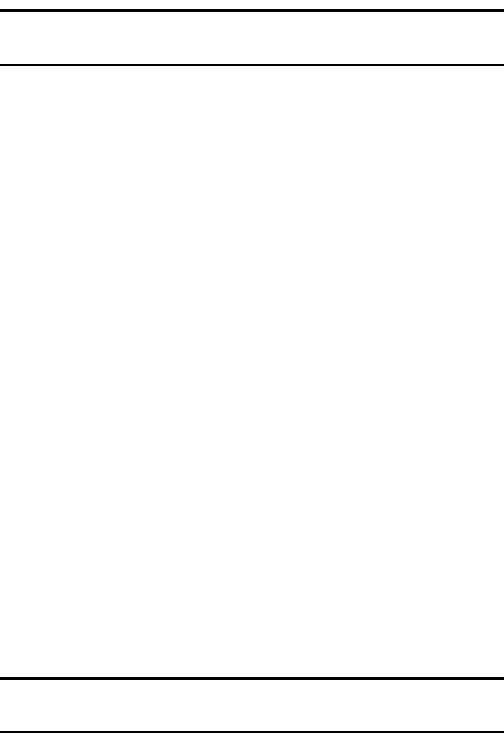
Section 2: Installing the PCS Connection Card
20 2A: Installation on Notebook PCs
end of the card, should be inserted directly into the
computer’s PC Card slot.
Note: The PCS Connection Card should fit snugly, but you should be able
to insert or remove it easily from your computer’s PC Card slot.
When you insert the card, the following should occur:
ᮣIf sound effects are enabled, the PC beeps.
ᮣThe PC Card icon appears in the status area, if it is not
already displayed for another card (and unless the feature
has been disabled).
ᮣThe PCS Connection Manager Software launches (unless
the auto-launch feature has been disabled).
The card is powered as soon as you insert it.
Removing the PCS Connection Card
To remove the card:
1. Close the PCS Connection Manager program if it is open.
2. Click the PC Card icon in the status area to display the
option to stop the card.
3. Click “Stop PCS Connection Card Parent” (Windows 98
SE, 2000, or Me) or “Safely remove PCS Connection Card
Parent” (Windows XP).
4. If a dialog box appears notifying you that it is safe to
remove the card, click OK.
5. Use the ejector to remove the card from the slot.
Activating Your PCS Connection Card
The final step to making the PCS Connection Card
operational is configuring it to use your account.
Tip: For an overview of account activation and configuration, see
"Activating and Using PCS Service" on page 8.
If you purchased a pre-activated PCS Connection Card, this
step is not necessary. Once the application software and
driver are installed, the card is ready for use.
Otherwise, you must use the Sprint Activation Wizard to
activate and configure your account. Future releases of the
Section 2: Installing the PCS Connection Card
2A: Installation on Notebook PCs 21
PCS Connection Manager Software will allow for both
Manual and Voice-Assisted Activation, but only Manual
Activation is available in this release. Manual Activation
involves phoning PCS Customer Service Solutions,
exchanging information and entering your account
information into the appropriate fields in the wizard. You
require a separate phone to use this method.
To activate an account and configure your PCS Connection
Card:
1. Insert the card into your PC Card slot, if it is not already
inserted.
2. If the Activation Wizard does not appear automatically,
launch the PCS Connection Manager Software. Double-
click the shortcut icon on your desktop or select Start >
Programs > Sierra Wireless> AirCard 550 > PCS Connection
Manager for AirCard 550.
3. From the PCS Connection Manager, launch the Activation
Wizard by selecting MENU > Activation Wizard.
4. Use the Next and Back buttons to navigate through the
Activation Wizard, noting the following:
ᮣUse the radio button to select Manual Activation as the
method of activation you want to use.
ᮣObtain the billing information listed on the second
window of the wizard before phoning PCS Customer
Service Solutions or proceeding to the next window.
ᮣPlease telephone PCS Customer Service Solutions to
set up your PCS wireless network account.
• If you will be using your PCS Connection Card
primarily for business purposes, call 1-877-789-3969.
• If your card is intended primarily for personal use,
call 1-888-715-4588.
ᮣInform your PCS Customer Solutions Specialist that
you are activating a PCS Connection Card by Sierra
Wireless (AirCard 550). The representative will
request your ESN (electronic serial number). This is
displayed in the Activation Wizard (and is printed on
the PCS Connection Card box and on the label on the
back of the card).
5. Click Finish on the final window of the wizard.
On completion of this step, the card is ready for use for voice
calls and receiveing Wireless Web Messages. When you make
Section 2: Installing the PCS Connection Card
22 2A: Installation on Notebook PCs
your first data connection, the card will use IOTA (Internet
Over The Air) to obtain and activate your data services. This
account setup is performed for you by making a data
connection to the PCS Vision network and using a secure
(encrypted) Internet connection to download account
parameters to the AirCard 550 PCS Connection Card.
After this first activation, there may be changes to your
account that will require updating parameters in the
AirCard 550 PCS Connection Card. If this is needed you can
select MENU > Data Provisioning to have the PCS Connection
Card retrieve the updates to your data services account.
Section 3A: The PCS Connection Manager Window and
Indicators on page 35 explains how to use the
PCS Connection Manager Software to manage and monitor
your connections.

Section 2: Installing the PCS Connection Card
2B: Installation on Handheld and Pocket PCs 23
Section 2B
Installation on Handheld and
Pocket PCs
In This Section
ᮣSystem Requirements
ᮣInstalling the PCS Connection ManagerSM Software
ᮣInserting and Removing the PCS Connection CardTM
ᮣConfiguring Your Account
his chapter guides you through the steps necessary to
install your PCS Connection Card and make it operational
on a Handheld or Pocket PC. This requires that you install the
PCS Connection Manager Software and activate and configure
your account (unless the card is pre-activated).
T
Section 2: Installing the PCS Connection Card
24 2B: Installation on Handheld and Pocket PCs
Getting Started
Since software cannot be installed directly to a Handheld/
Pocket PC, you require a desktop or notebook computer to
function as a “host”. The installation, activation, and
configuration process follows these steps:
1. Install the software to the host.
2. Connect the Handheld/Pocket PC to the host and
download the software from the host to the Handheld/
Pocket PC. (You can connect the Handheld/Pocket PC to
the host before or after you install the software to the
host.)
3. If the card has not been pre-activated, use the Sprint
Activation Wizard to configure the card.
Before you begin the installation, ensure you have the
necessary hardware, software, and system resources
described in the next section.
System Requirements
The minimum system requirements for both Pocket PCS and
Handheld PCS (as well as their host computers) are as
follows:
Pocket PC System Requirements
Operating System:
ᮣWindows CE 3.0 MS Pocket PC, or
ᮣWindows CE 3.0 Pocket PC 2002
If you do not know what version of Windows CE you are
using, select Start > Settings, tap the System tab, and tap the
About icon. If the second line on the screen reads,
“Windows 3.0.9348 (Build…)”, your operating system is
Windows CE 3.0 MS Pocket PC. If the second line reads,
“Windows 3.0.11171 (Build…)”, your operating system is
Windows CE 3.0 Pocket PC 2002.
Your Pocket PC must have:
ᮣ900 kB of storage memory
ᮣThe PCMCIA jacket accessory (with a PC Card slot)
ᮣA method of connecting to a host computer, using either
a serial autosync cable, USB autosync cable, or infrared
ports
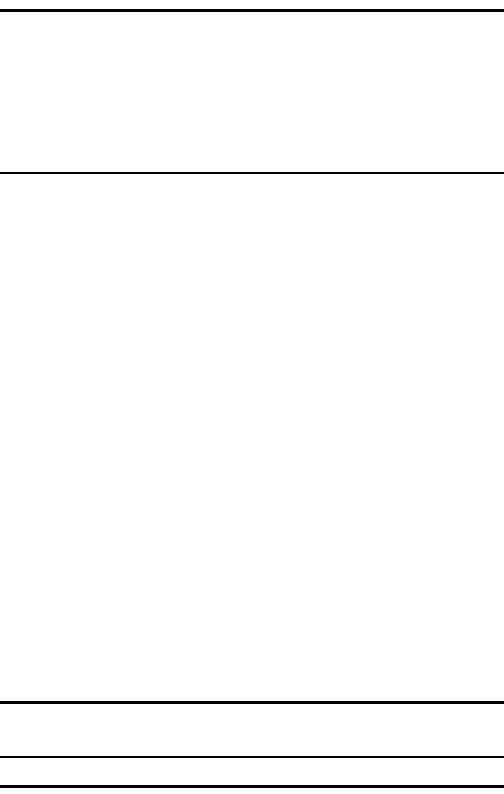
Section 2: Installing the PCS Connection Card
2B: Installation on Handheld and Pocket PCs 25
Special Note for Pocket PC Users: To function properly with IOTA
protocol, the PCS Connection Card requires support for high-security 128-bit
encryption. If the installer does not detect high-security support on your
system, a warning will appear instructing you to install Microsoft High
Encryption Pack for Pocket PC. Your host computer will then display a pop-up
window instructing you to upgrade your Pocket PC Internet Explorer to
support high encryption. Follow the onscreen instructions to update your
system.
Handheld PC System Requirements
Operating System:
ᮣWindows CE 3.0 Handheld PC 2000
Your Handheld PC must have:
ᮣ900 kB of storage memory
ᮣA PC Card slot
ᮣA method of connecting to a host computer, using either
a serial autosync cable or infrared ports
Host System Requirements
Whether you are using a Handheld or Pocket PC, you require
a desktop or notebook computer to function as the host that:
ᮣHas the necessary port (serial, USB, or infrared) to
connect to the Handheld/Pocket PC
ᮣHas a CD-ROM drive
ᮣIs running Windows 98 SE or 2000
ᮣHas ActiveSync version 3.1 or 3.5 installed (ActiveSync 3.5
is required if you are using Windows CE 3.0 Pocket PC
2002)
Tip: ActiveSync is made by Microsoft and is included with all Handheld/
Pocket PCS running Windows CE 3.0.
Special Note for Handheld PC Users: To function properly with IOTA
protocol, the PCS Connection Card requires support for high-security
128-bit encryption. If the installer does not detect high-security support on
your system, it will automatically update your Handheld PC with an XML
extension provided by Hewlett Packard. When your Handheld PC displays
“Install HP msxml,” tap OK to complete the installation. Your host computer
will then display a pop-up window instructing you to upgrade your

Section 2: Installing the PCS Connection Card
26 2B: Installation on Handheld and Pocket PCs
Handheld PC Internet Explorer to support high encryption. Follow the
onscreen instructions to update your system.
Installing the PCS Connection ManagerSM
Software
To install the software, you can either:
ᮣConnect the host and the Handheld/Pocket PC before you
install the software to the host. (In this case, you are
prompted to initiate the download as soon as the
software installation is complete.)
– or –
ᮣInstall the software to the host and then connect the host
and the Handheld/Pocket PC, as described here.
This process installs the PCS Connection Manager Software
and the PCS Connection Card drivers.
Installing the PCS Connection Manager Software on the Host
To install the software on the host:
1. Close any Windows programs that are running and insert
the PCS Connection Manager installation CD in your CD-
ROM drive. The CD should auto-start and display a menu.
2. If the CD does not auto-start, select Start > Run and enter
d:\launch.exe where d is the drive letter of your CD-ROM
drive.
3. From the CD start-up window, select:
ᮣPocket PC installation and documentation then Pocket PC
software installation (if you have a Pocket PC running
Windows CE 3.0 MS Pocket PC), or
ᮣPocket PC 2002 installation and documentation then
Pocket PC 2002 software installation (if you have a Pocket
PC running Windows CE 3.0 Pocket PC 2002), or
ᮣHandheld PC 2000 installation and documentation then
Handheld PC 2000 software installation (if you have a
Handheld PC running Windows CE 3.0)
This launches the InstallShield® Wizard that installs the
software to the host.
Section 2: Installing the PCS Connection Card
2B: Installation on Handheld and Pocket PCs 27
4. Use the Next and Back buttons to navigate through the
wizard noting the following:
ᮣYou must indicate your acceptance of the terms of the
license agreement by clicking Yes to proceed with the
installation.
ᮣUsing the default settings for the Destination Location
and Program Folder is recommended unless you have
special requirements and an advanced understanding
of PC configuration. (The Destination Location
dictates where the software is installed. The Program
Folder dictates the name assigned to the software in
the Add/Remove Programs in the Control Panel.)
ᮣA dialog box displays this message, “On the next
mobile device connection, the installed application
will be downloaded to the device.” Click OK.
ᮣA check box allows you to choose to display release
notes. The release notes list known issues in the
software and are displayed in the Windows Notepad.
(If you choose to display them, when you are finished
reading, use the close box in the upper right corner of
the window to close the Notepad.)
ᮣClick Finish to close the last screen of the wizard.
ᮣUse the exit option in the lower left corner of the
window to close the CD start-up menu.
Downloading the Software to the Handheld/Pocket PC
To download the software to the Handheld/Pocket PC:
1. Connect the Handheld/Pocket PC to the host in one of
these ways:
Pocket PCs:
ᮣConnect one end of the serial cable to the bottom of
the Pocket PC and the other end to a serial port on
your host PC, or
ᮣPlace your Pocket PC in its cradle and connect the USB
cable on the cradle to a USB port on your host PC, or
ᮣAlign the infrared port on your Pocket PC with an
infrared port on your host PC.
Handheld PCs:
ᮣPlace your Handheld PC in its docking cradle and
connect the serial cable on the cradle to a serial port
on your host PC, or

Section 2: Installing the PCS Connection Card
28 2B: Installation on Handheld and Pocket PCs
ᮣAlign the infrared port on your Handheld PC with an
infrared port on your host PC.
ActiveSync should launch automatically when the host and
Handheld/Pocket PC are connected.
Note: If you are unable to establish a connection, launch ActiveSync from
the Start menu and use the online help in ActiveSync.
2. If you are prompted to indicate whether you want to set
up a partnership, click Yes or No and click Next. (For the
purpose of downloading the PCS Connection Manager
Software, it does not matter whether you have a
partnership.) You should then be prompted that there is
software to download.
3. Click Yes to start the download. When complete, you will
be prompted to check your mobile device screen to see if
additional steps are required.
4. Click OK.
5. Reset your Handheld/Pocket PC by inserting the stylus
into the reset button. (The reset button is usually a
circular indentation that may be on the keyboard of the
Handheld PC or the bottom of the Pocket PC. Consult the
documentation that came with your PC if you do not
know how to reset the device.)
On completion of this step, the PCS Connection Manager
Software and the PCS Connection Card driver are installed
and you can proceed to activate your card. See “Activating
Your PCS Connection Card” on page 29.
Inserting and Removing the PCS Connection
Card
Inserting the PCS Connection Card
To insert the PCS Connection Card into a Pocket PC:
1. If the PCMCIA jacket accessory is not already attached,
slide the Pocket PC bottom first into the jacket. It should
click into place.
2. Attach the antenna to the circular copper connector on
the end of the card. DO NOT FORCE.
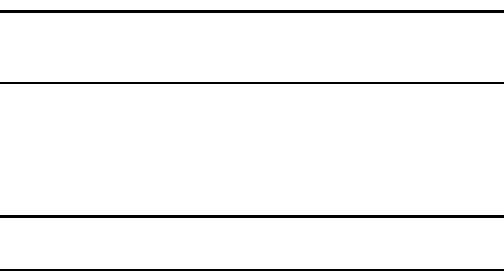
Section 2: Installing the PCS Connection Card
2B: Installation on Handheld and Pocket PCs 29
3. With the Sprint label facing towards the front of the
Pocket PC, insert the network card into the slot at the top
of the jacket.
To insert the PCS Connection Card into a Handheld PC:
1. Attach the antenna to the circular copper connector on
the end of the card. DO NOT FORCE.
2. With the Sprint label facing towards the top of the
Handheld PC, insert the network card into the slot.
The card is powered as soon as you insert it.
Removing the PCS Connection Card
ᮣUse the ejector to release the card and remove it from the
slot.
Note: On Pocket PCs, anytime you eject and re-insert the PCS Connection
Card, restart your PC by turning it off and on again. This step is necessary
to ensure the communication port detects the card.
Activating Your PCS Connection Card
The final step to making the PCS Connection Card
operational is configuring it to use your account.
Tip: For an overview of account activation and configuration, see
"Activating and Using PCS Service" on page 8.
If you purchased a pre-activated PCS Connection Card, this
step is not necessary. Once the application software and
driver are installed, the card is ready for use.
Otherwise, you must use the Sprint Activation Wizard to
activate and configure your account. Future releases of the
PCS Connection Manager Software will allow for both Manual
and Voice-Assisted Activation, but only Manual Activation is
available in this release. Manual Activation involves phoning
PCS Customer Service Solutions, exchanging information and
entering your account information into the appropriate fields
in the wizard. You require a separate phone to use this
method.
Section 2: Installing the PCS Connection Card
30 2B: Installation on Handheld and Pocket PCs
To activate an account and configure your PCS Connection
Card:
1. Insert the card into your PC Card slot, if it is not already
inserted.
2. If the Activation Wizard does not appear automatically,
launch the PCS Connection Manager Software. Double-
click the shortcut icon on your desktop or select Start >
Programs > Sierra Wireless> AirCard 550 > PCS Connection
Manager for AirCard 550.
3. From the PCS Connection Manager, launch the Activation
Wizard by selecting MENU > Activation Wizard.
4. Use the Next and Back buttons to navigate through the
Activation Wizard, noting the following:
ᮣUse the radio button to select Manual Activation as the
method of activation you want to use.
ᮣObtain the billing information listed on the second
window of the wizard before phoning PCS Customer
Service Solutions or proceeding to the next window.
ᮣPlease telephone PCS Customer Service Solutions to
set up your PCS wireless network account.
• If you will be using your PCS Connection Card
primarily for business purposes, call 1-877-789-3969.
• If your card is intended primarily for personal use,
call 1-888-715-4588.
ᮣInform your PCS Customer Solutions Specialist that
you are activating a PCS Connection Card by Sierra
Wireless (AirCard 550). The representative will
request your ESN (electronic serial number). This is
displayed in the Activation Wizard (and is printed on
the PCS Connection Card box and on the label on the
back of the card).
5. Click Finish on the final window of the wizard.
On completion of this step, the card is ready for use for voice
calls and receiveing Wireless Web Messages. When you make
your first data connection, the card will use IOTA (Internet
Over The Air) to obtain and activate your data services. This
account setup is performed for you by making a data
connection to the PCS Vision network and using a secure
(encrypted) Internet connection to download account
parameters to the AirCard 550 PCS Connection Card.
Section 2: Installing the PCS Connection Card
2B: Installation on Handheld and Pocket PCs 31
After this first activation, there may be changes to your
account that will require updating parameters in the
AirCard 550 PCS Connection Card. If this is needed you can
select TOOLS > Data Provisioning to have the PCS Connection
Card retrieve the updates to your data services account.
On completion of this step, the card is ready for use.
Section 3A: The PCS Connection Manager Window and
Indicators on page 35 explains how to use the
PCS Connection Manager Software to manage and monitor
your connections.
32
Section 3
Using the PCS Connection Card 33
Section 3
Using the
PCS Connection Card
34

Section 3: Using the PCS Connection Card
3A: The PCS Connection Manager Window and Indicators 35
Section 3A
The PCS Connection ManagerSM
Window and Indicators
In This Section
ᮣThe PCS Connection Manager
ᮣGetting Help
ᮣComponents of the PCS Connection Manager window
ᮣMenu items
ᮣTaskbar icons
his chapter outlines the PCS Connection Manager interface
for your PCS Connection Card, including the components
of the main window, button usage, taskbar icons and more.
Once you’ve mastered the basics here, you’ll be ready to begin
using your PCS Connection Card.
T

Section 3: Using the PCS Connection Card
36 3A: The PCS Connection Manager Window and Indicators
The PCS Connection Manager
PCS Connection Manager Software allows you to manage and
monitor the connection between your PCS Connection Card
and the CDMA network. Use the PCS Connection Manager
to:
ᮣDetermine your signal strength, roaming status,
PCS Vision availability, and other network connection
parameters
ᮣInitiate voice and data calls
ᮣView call statistics and Web messages
ᮣEnable and disable features like Always On Top (which
allows you to set the card software to display in front of
other application windows) and KeyGuard (which
prevents accidental dialing)
ᮣSet options related to Web messages, sounds played,
voice calls, and the lock code security feature (which you
can use to prevent others from using your card)
Anytime you use the PCS Connection Card you must run the
PCS Connection Manager Software.
Starting the PCS Connection Manager
Software
On a notebook PC, you can launch the PCS Connection
Manager Software by:
ᮣDouble clicking the icon on your desktop
ᮣSelecting Start > Programs > Sierra Wireless> AirCard 550
> PCS Connection Manager for AirCard 550
On a Handheld/Pocket PC, you can launch the
PCS Connection Manager Software by selecting Start >
Programs > PCS Connection Manager.
Depending on your settings in the Options window, the
software launches automatically anytime you insert the
PCS Connection Card.
Once you make a connection in the card software, you can
launch whatever application you want to use (such as your
Web browser or email application).
Section 3: Using the PCS Connection Card
3A: The PCS Connection Manager Window and Indicators 37
On Pocket PCs, when you open another application, the card
software remains running although it is not visible.
Windows CE manages your applications, shutting down
applications that are not being used in order to save memory.
It should not be necessary to close the card software, but you
can close the software by tapping CTRL + Q on the soft
keyboard.
On Handheld and notebook PCs, use the Close button in the
lower right corner to exit. See page 39.
Getting Help
Online Help is available on all platforms. See page 92
(notebook PCs), page 93 (Handheld PCs), and page 93
(Pocket PCs).
The PCS Connection Manager Window
The PCS Connection Manager window has these
components:
ᮣA menu button and keypad button in the lower left
corner
ᮣA Minimize and Close button in the lower right corner
ᮣA message area (in the upper left area)
ᮣAn indicator area (near the middle of the screen)
ᮣA button (“GO”) used to establish/cancel a connection
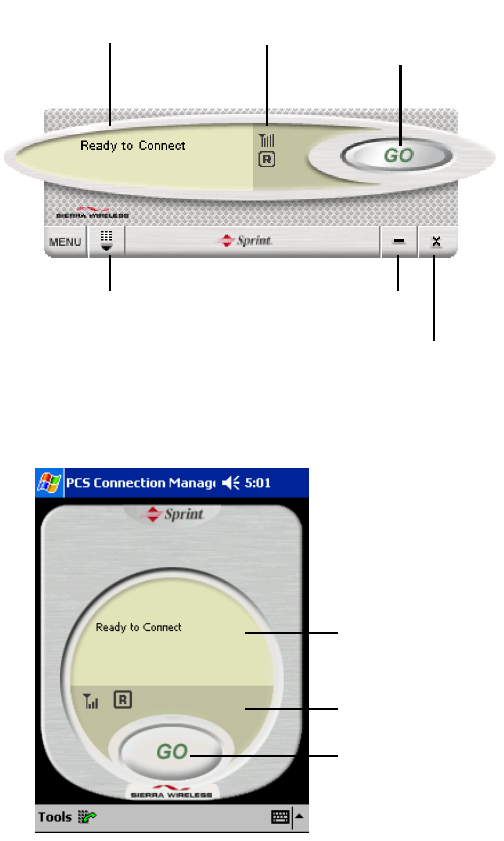
Section 3: Using the PCS Connection Card
38 3A: The PCS Connection Manager Window and Indicators
Notebook / Handheld PCs
Pocket PCs
Close
Minimize
Keypad button button
Message area Indicator area
button
Establish/cancel
a connection
Message area
Indicator area
Establish/cancel
a connection

Section 3: Using the PCS Connection Card
3A: The PCS Connection Manager Window and Indicators 39
Displaying the Menu Items
The menus are described in detail in "Menu Options" on page
63.
Notebook / Handheld PC: The MENU Button
To display the menu items, click the MENU button located in
the lower left corner of the PCS Connection Manager
window.
Pocket PC
To display the menu items, click Tools, located in the lower
left corner of the PCS Connection Manager window.
Keypad Button (Notebook / Handheld PCs)
The keypad button displays and hides the keypad,
used to place or answer voice calls. For more
information, see
"Using the Keypad" on page 55.
The Minimize and Close Buttons (Notebook / Handheld PC)
The Minimize button closes the window but leaves the
program running. When the program is minimized, its icon
in the status area can be used to determine the card status.
(See page 46.)
Once minimized, you can redisplay the program by double
clicking the desktop shortcut or launching the card software
from the Start menu. (See page 36.) You can also click the
icon in the status area. (The icons are shown in the section
“Taskbar Icons” on page 46.)
The Close button is used to exit the card software.

Section 3: Using the PCS Connection Card
40 3A: The PCS Connection Manager Window and Indicators
Message Area
Notebook and Handheld PCs
Pocket PCs
Description
The message area displays one of these messages:
ᮣReady to Connect indicates that you have a network
connection but there is no call in progress.
ᮣDialing indicates that the PCS Connection Card is
attempting to connect to a phone number.
ᮣThe name of the person with whom you are connecting (or
“Unknown” if the name is not obtainable), and the phone
number indicate that a voice call is being established.
ᮣIn Use and time counters indicate that the voice call is
answered.
ᮣRx…Tx… indicates that a data call is in progress. Rx shows
the number of bytes of data received. Tx shows the
number of bytes of data transmitted.
ᮣConnected to indicates a PCS Vision data connection is
established.
Section 3: Using the PCS Connection Card
3A: The PCS Connection Manager Window and Indicators 41
ᮣVoice Call From… indicates that an incoming voice call is in
progress.
ᮣRoam Call From … indicates that an incoming voice call is
in progress and you are roaming.
ᮣ… New Missed Call(s) indicates that you received a call (or
calls) that you failed to answer. (Depending on your
settings in the Options window, a record of these calls is
maintained in the Call Log which is described on
page 71.)
ᮣYou have new voicemail! indicates that you have new
voicemail messages.(For more information on voicemail,
see page 61.)
ᮣProvisioning Complete indicates that your account has
successfully been set up or changed.
ᮣNot Activated indicates that your account has not been set
up. Run the Activation Wizard. (Notebook users: see
“Configuring Your Account” on page 20; Handheld/
Pocket PC users: see “Configuring Your Account” on
page 29.)
ᮣService Required indicates that you should contact
PCS Customer Service Solutions.
For other messages, see “Troubleshooting Tips
(Notebook PC)” on page 101 or “Troubleshooting Tips
(Handheld / Pocket PC)” on page 119.

Section 3: Using the PCS Connection Card
42 3A: The PCS Connection Manager Window and Indicators
Indicator Area
Notebook / Handheld PCs
Pocket PCs
The indicator area displays icons that notify you when you
receive messages and indicate whether certain options and
features are enabled.

Section 3: Using the PCS Connection Card
3A: The PCS Connection Manager Window and Indicators 43
Table 1: Indicator Area Icons
Icon Meaning
Note: This icon is displayed only when voice and data
services are available.
The Signal Strength indicator uses bars to show the
intensity of the radio signal. The number of bars
increases as signal strength increases to a maximum of
four bars.
Tip: Optimal signal strength is obtained when the
antenna is perpendicular to the card.
When no bars are shown, no connection is possible for one
of these reasons:
ᮣNo antenna is attached
ᮣYou are outside the CDMA network coverage area
ᮣThe signal strength is too weak
ᮣA network or account problem is preventing the
PCS Connection Card from obtaining service
Once a connection is established, th is i co n is r ep l ac e d by
the Transmit/Receive icon (shown on page 44).
The silent ringer feature is enabled. When an incoming
call is received, no sound is played. You can enable and
disable this feature under MENU > Options. (Page 77.)
Encryption is in use on voice calls. (Encryption prevents
your calls from being monitored.) The PCS Connection
Card uses encryption where it is available on the
network.
A voice call is in progress.
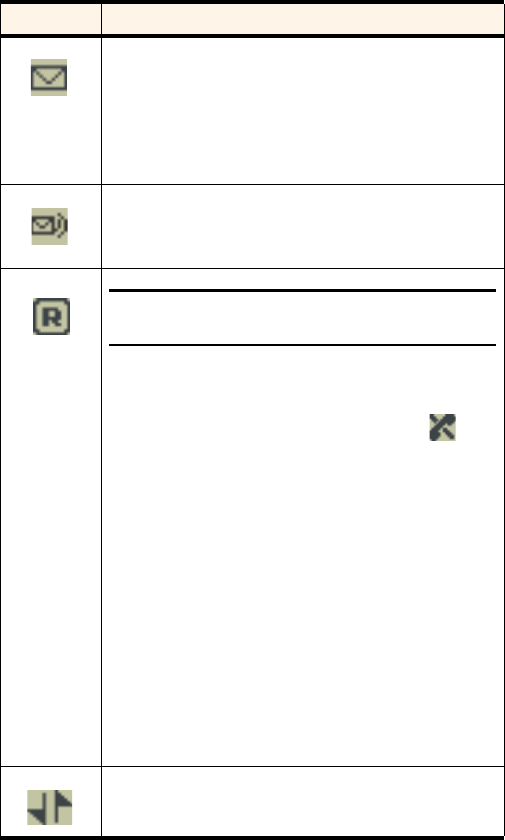
Section 3: Using the PCS Connection Card
44 3A: The PCS Connection Manager Window and Indicators
You have unread Web messages. If the indicator is
blinking, you have one or more urgent or important
unread Web messages.
To display the Web Messaging window (in which the
messages are displayed), select MENU > Web Messaging….
For instructions on reading Web messages, see page 65.
You have new voicemail.
To retrieve your voicemail, press and hold the “1” key for
about 2 seconds.
Note: This icon is displayed only when voice and data
services are available.
The Roaming Status indicator shows whether you are
roaming off of the Sprint Nationwide PCS Network.
When the indicator is not displayed and the icon is not
displayed, you are within the Sprint Nationwide
PCS Network.
When the indicator is on (solid black), you are in a
“preferred” roaming area.
When the indicator is blinking, you are within the
coverage area of a CDMA network but not in a “preferred”
roaming area.
Your coverage area and billing charges depend upon
Sprint and the type of account you have. There may be
surcharges for roaming service that vary based on
whether you are in a preferred roaming area or a non-
preferred roaming area. If there is no roaming agreement
between Sprint and the local carrier, you may be unable
to complete calls in non-preferred roaming areas.
When the Transmit/Receive icon is solid, a PCS Vision
data connection is active.
Table 1: Indicator Area Icons (Continued)
Icon Meaning

Section 3: Using the PCS Connection Card
3A: The PCS Connection Manager Window and Indicators 45
When the Transmit/Receive icon is gray, the PCS Vision
data connection is dormant. For more information, see
page 52.
When the Transmit/Receive icon is crossed out,
PCS Vision service is not available.
Note: This icon is displayed only when voice and data
services are available.
Voice and data services are not available.
Table 1: Indicator Area Icons (Continued)
Icon Meaning
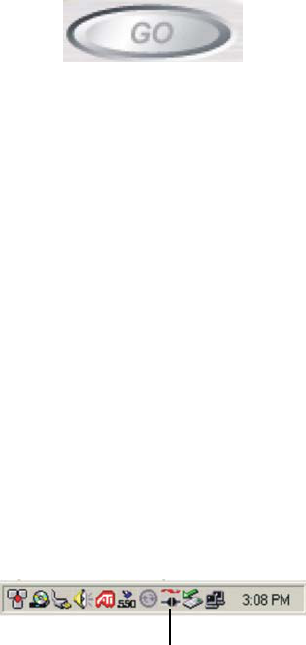
46
GO Button
The GO button is used to establish and cancel a connection.
The text on the button changes during different connection
stages:
ᮣGO – Ready to establish a connection. Click the button to
start a connection (if a default connection is defined), or
to display a list from which you can select a connection (if
more than one connection is defined and there is no
default set).
ᮣStop – A connection is being established or is established.
If you click the button, the connection will be canceled.
Taskbar Icons
The PCS Connection Manager Software displays an icon in
the status area. The status area icon indicates your
connection status or notifies you when you have voicemail or
Web messages, or when you have missed a call.
On notebooks and Handheld PCs, the icon is in the status
area (which is located in the lower right corner of your
screen).
On Pocket PCs, the icon is on the Today screen.
Status Icon (active)

Section 3: Using the PCS Connection Card
3A: The PCS Connection Manager Window and Indicators 47
Status Icons
Table 2: Status Area Icons
Icon Meaning
You are in service on the CDMA network but have no
active voice or data connection.
You have an active voice or data connection.
You missed (failed to answer) an incoming call. You
can view the number of the caller in the Call Log.
You have unread Web message(s).
You have voicemail.
48

Section 3: Using the PCS Connection Card
3B: Data Connections 49
Section 3B
Data Connections
In This Section
ᮣBasic Data Connection Information
ᮣPCS Vision Connections
his section provides an overview of the high-speed data
connection available through your PCS Connection Card
and how best to take advantage of the card’s versatility.
T

Section 3: Using the PCS Connection Card
50 3B: Data Connections
The Basics
The GO button on the PCS Connection Manager window is
used to launch data connections for any of these purposes:
ᮣBrowsing the Internet
ᮣSending and receiving email
ᮣUploading and downloading files (FTP)
The PCS Connection Card functions as a network card using
a PCS Vision data connection. In this type of connection, the
card establishes a high-speed (PCS Vision) Internet connection
to the CDMA network. (You do not need to provide a phone
number and there is no dialing involved.) This connection has
average speeds of 50-70 kbps with a maximum speed of up to
144 kbps.
Note: You cannot make phone calls with the PCS Connection Card during
active PCS Vision connections. You can make phone calls during dormant
PCS Vision connections. (See page 52.)
The PCS Vision connection provides access to the Internet.
Once the connection is established, you can open your
browser and connect to any Web site that is accessible
through the Internet, or access other Internet services (such
as email).
The PCS Connection Card is “active” in a PCS Vision
connection when data transmission is occurring. If data
transmission stops for a period of time, the card becomes
“dormant”. (See page 52.) You can place voice calls while the
card is dormant, but not while the card is active.
If you also use another wireless network card with your
computer, eject the additional card before you use the
PCS Connection Card. Under some operating systems, if both
cards are inserted, then the path that the Internet
Protocol (IP) traffic will take is not predictable. If the data
gets routed through the other card, you will experience
slower data transfer rates.
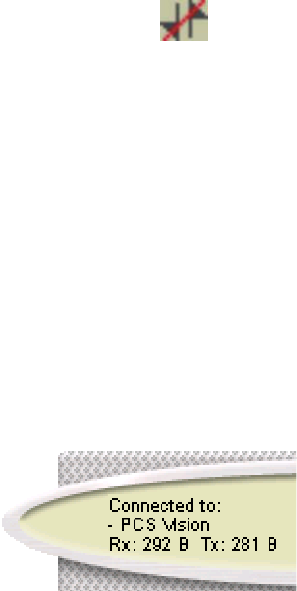
Section 3: Using the PCS Connection Card
3B: Data Connections 51
PCS Vision (High-Speed) Connections
Important: If the following icon appears in the indicator area of
the PCS Connection Manager window, you do not currently
have PCS Vision service and cannot make a connection:
At installation, the PCS Vision connection profile is created
for you by the Connection Manager, and it is set as the
default connection.
To make a PCS Vision connection:
1. From the PCS Connection Manager window, click the GO
button.
2. If the PCS Vision connection is the default connection,
then the connection will start. (This connection definition
is set up during installation.)
If more than one connection is defined and there is no
default set, then the Connections popup window
displays. Select the connection you want to use.
The PCS Connection Manager program initiates the
connection. Progress is shown in the message area
(“Dialing”, “Authenticating”). Once the connection is
established, the number of bytes received and transmitted
are displayed:
If you are running Windows 2000 or Windows XP and having
problems establishing a connection, see page 104.
Once the connection is established, you can use any Internet
application (such as Internet Explorer, Netscape Navigator,
or your email application).
To end a PCS Vision connection:
ᮣClick the Stop button.

Section 3: Using the PCS Connection Card
52 3B: Data Connections
Dormant Connection
The PCS Connection Card is “active” during PCS Vision
connections when data transmission is occurring. If data
transmission over the network stops for a period of time, the
card becomes “dormant”. The period of inactivity that causes
the card to become dormant is set by Sprint and is always less
than one minute. This permits the card to be used for voice
calls when not actively needed for data.
When the card is in this state, you are able to make phone
calls with the card. You will not be able to transmit data (for
example, you won’t be able to browse the Web) during the
phone call, but the connection is not lost. When you end the
phone call, data transmission is automatically resumed.
When the card has an active PCS Vision connection, you
cannot make phone calls.
Note: Some programs may be unable to function on a dormant connection.
During dormant PCS Vision connections, the connection
icon in the indicator area of the PCS Connection Manager
window is grayed out:

Section 3: Using the PCS Connection Card
3C: Voice Connections 53
Section 3C
Voice Connections
In This Section
ᮣThe Keypad
ᮣOutgoing Calls
ᮣIncoming Calls
ᮣVoicemail
ou can use your PCS Connection Card to transform your
notebook or pocket PC into a mobile phone simply by
connecting a headset to the card and using the PCS Connection
Manager interface to place and receive voice calls.
Y

Section 3: Using the PCS Connection Card
54 3C: Voice Connections
Voice Connection Features
The PCS Connection Card offers many convenient voice
features:
ᮣThe volume control allows you to adjust the headset
volume.
ᮣSelecting the TALK button allows you to redial the
previously dialed number.
ᮣAny-Key Answer allows you to answer an incoming call by
pressing any button on the keypad (except END, BACK, or
the volume control). (Page 83.)
ᮣAuto-Answer can be enabled to automatically answer
incoming calls after a specified number of rings.
(Page 82.)
ᮣThe KeyGuard feature prevents accidental dialing.
(Page 74.)
ᮣThe Silent Ringer prevents any sound from occurring
when you receive calls. (Page 78.)
ᮣThe Phone Book allows you to keep a record of frequently
used phone numbers and to dial a number simply by
double clicking it. (Page 67, page 71.)
ᮣThe Call Log records details about all incoming and
outgoing calls, providing useful information such as the
phone numbers of missed calls. (Page 71.)
ᮣIf your PCS Service Plan includes Three-Way Calling,
Voicemail, Call Alert or Caller ID, they are supported by
the card.
Tip: Many voice features are configured in the Voice Options window. See
page 82.
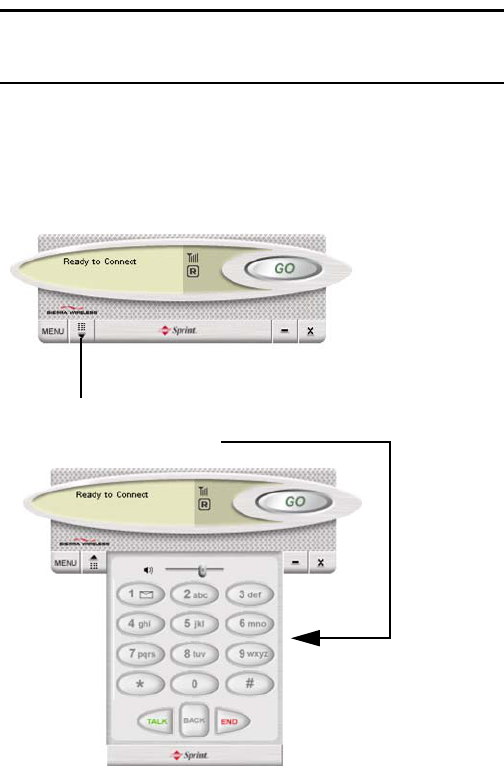
Section 3: Using the PCS Connection Card
3C: Voice Connections 55
Using the Keypad
The keypad is used to answer and place voice calls. The
keypad performs the same functions as the keypad on a
mobile phone.
Tip: You can store frequently dialed numbers in the Phone Book and dial
directly from the Phone Book window instead of entering the number on the
keypad. See page 67 (notebook PCs) or page 71 (Handheld/Pocket PCs).
Notebook / Handheld PC
The keypad is displayed when you click the keypad button,
located next to the MENU button in the lower left corner of
the PCS Connection Manager window.
1. Click the keypad button
2. The keypad appears
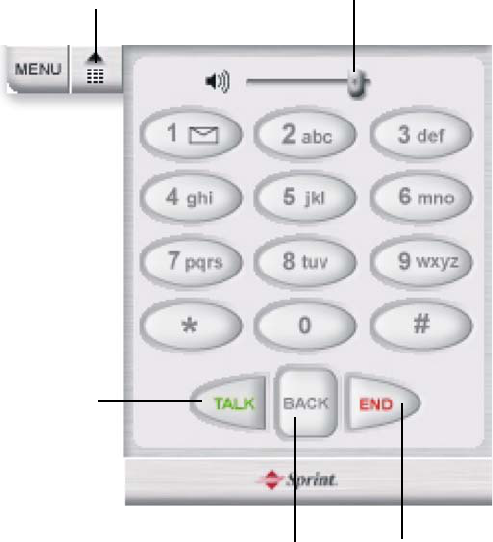
Section 3: Using the PCS Connection Card
56 3C: Voice Connections
Volume control
Open/close
the keypad
Place and
answer
calls
Clear a number
you’ve entered
End a call;
clear status
messages
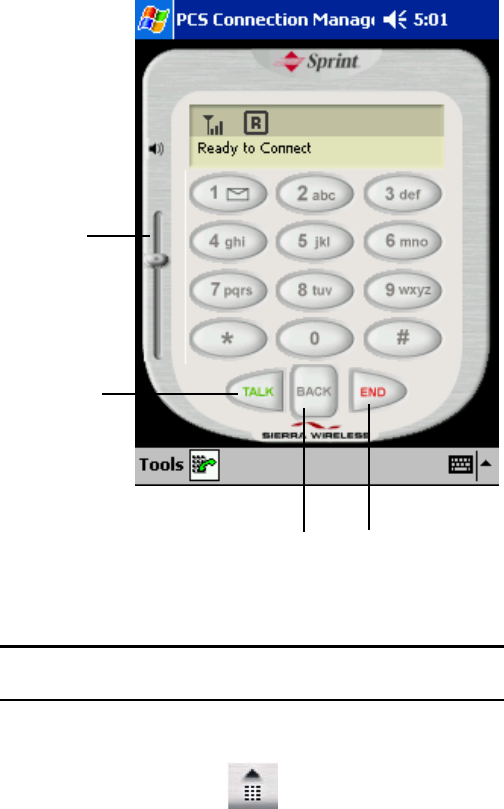
Section 3: Using the PCS Connection Card
3C: Voice Connections 57
Pocket PC
The keypad is displayed when you tap Tools > Voice Call.
Note: When KeyGuard is on, clicking the buttons on the keypad has no
effect. For information on KeyGuard, see page 74.
Notebook / Handheld PC: To hide the keypad, click the keypad
button
Pocket PC: To switch from the keypad to the data connection
screen, tap Tools > Connections.
V
olume
Place and
Clear a number
you’ve entered
End a call;
clear status
messages
c
ontrol
answer calls

Section 3: Using the PCS Connection Card
58 3C: Voice Connections
Table 3: The PCS Connection Manager Keypad
Keypad Buttons Function
0-9, #, *
(or the same keys on
your keyboard)
Enter the digits (and other characters) you want
to dial. The numbers are displayed in the
message area until you press TALK, END, or BACK,
or you receive an incoming call.
If the Any-Key Answer feature is enabled, any of
these keys can be used to answer an incoming
call. (See page 83.)
If you click (or press) these buttons during a
call, the card beeps and the characters are
displayed in the message area.
1In addition to acting as a number key, the 1 key
can be used to access voicemail. Press and hold
the key for approximately 2 seconds to connect
to your voicemail.
TALK
(<Enter> on your
keyboard)
Place and answer incoming calls. When you are
not receiving an incoming call, TALK dials the
numbers in the message area. If no numbers are
displayed, the card redials the last number you
dialed.
END
(<Esc> on your
keyboard)
End a call or clear all the digits and characters in
the message area (cancel a call that you’ve
started to enter).
This button also clears most status messages.
BACK
(<Backspace> on your
keyboard)
Clear the last number you’ve entered. Press and
hold BACK to clear an entire entry.
Volume Control Increase or decrease the headset volume.
Notebook, Handheld PCs: To increase the
volume, move the slider to the right. To
decrease the volume, move the slider to the left.
Pocket PCs: To increase the volume, move the
slider up. To decrease the volume, move the
slider down.
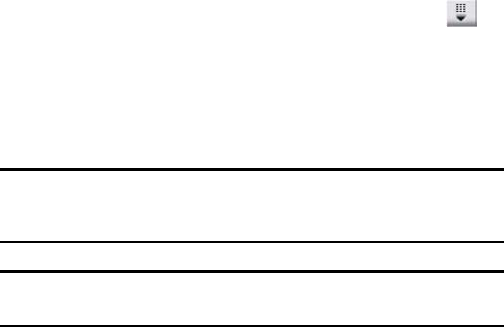
Section 3: Using the PCS Connection Card
3C: Voice Connections 59
Outgoing Calls
To initiate a call:
1. Connect a headset to the card, if one is not already
connected.
2. If the keypad is not displayed, then:
Notebook / Handheld PC: click the keypad button.
Pocket PC: tap Tools > Voice Call.
3. Enter the number you want to dial by either clicking the
number buttons on the keypad or typing the numbers on
your keyboard.
4. Click the TALK button.
Note: You cannot make a phone call when there is an active PCS Vision
connection. You can make phone calls during dormant PCS Vision
connections. For information on dormancy, see page 52.
Tip: If you click the TALK button without entering a number, the card
redials the last number you dialed.
If you are roaming and Call Guard is enabled (page 92), the
card beeps and a screen appears stating that a roaming rate
applies.
As the call is being dialed, the PCS Connection Manager
displays “Dialing” and the phone number.
Once the call is answered, “In Use” is displayed.
You can also dial a number from the Phone Book (see page
67 for notebook PCS and page 71 for Handheld/Pocket PCs)
and from the Call Log (see page 71).

Section 3: Using the PCS Connection Card
60 3C: Voice Connections
Incoming Calls
When you receive an incoming call:
ᮣA sound is played, unless the Silent Ringer feature is
enabled.
ᮣThe keypad is displayed.
ᮣIf you have Caller ID, the phone number and, if available,
the name of the caller are displayed.
ᮣIf you are roaming and Call Guard is enabled (page 92),
then the card beeps and a screen appears, stating that a
roaming rate applies.
Tip: The Options window, displayed when you select MENU > Options,
allows you to customize the sound played when you receive an incoming
call and to enable and disable the Silent Ringer feature. (See page 78.)
Note: If an incoming call occurs while you have an active data connection,
your caller will get a busy signal or be put through to your voicemail box.
To answer a call:
1. Connect a headset to the card, if one is not already
connected.
2. Click the TALK button.
The indicator area displays the connection icon ; the
message area displays “In Use” and shows the duration of
the call.
Tip: If the Any-Key Answer feature is enabled, tap any key except END or
BACK. On the Pocket PC, you can also use any of the four application
buttons. On the notebook and Handheld PC, you can also use keys on your
keyboard: A through Z, 0 through 9 and the * or # key.

Section 3: Using the PCS Connection Card
3C: Voice Connections 61
Voicemail
Incoming calls may be put through to your voicemail box, if:
ᮣA calls arrives while you have an active data connection,
or
ᮣYou do not answer an incoming voice call
When you have new voicemail:
ᮣThe following icons are displayed: in the indicator
area, and in the status area (page 47)
ᮣThe message area displays the message “You have new
voicemail!”.
You can also set a sound to play when you have new
voicemail (page 79).
To retrieve your voicemail:
ᮣPress and hold the “1” key for about 2 seconds.
If required, you can change the phone number for your voice
messaging system. See page 86.
62

Section 3: Using the PCS Connection Card
3D: Menu Options 63
Section 3D
Menu Options
In This Section
ᮣOverview of Menu Items
ᮣDescription of Menu Items
his chapter provides an overview and brief description of
each menu option you may encounter while using your
PCS Connection CardTM and PCS Connection ManagerSM
Software.
T

Section 3: Using the PCS Connection Card
64 3D: Menu Options
Overview of menu items
The following table outlines the various menu items and
provides a brief description and directions on where in this
guide to find more detailed information about the item.
Table 4: Menu Items
Menu item Description For more
information,
see:
Connect Establish a data connection. Page 51
Wireless Web
Messaging
Read Web messages sent to
you.
Page 65
Phone Book Store phone numbers and
email addresses of people
you are in frequent contact
with.
Page 67
Call Log View information on
outgoing and incoming calls.
Page 71
KeyGuard Prevent accidental dialing. Page 74
Activation Wizard Configure the card to use
your account.
Page 74
Data Provisioning Obtain or update your
PCS Vision data account
parameters.
Page 75
Software Updates Check for updates to the
PCS Connection Card or the
Connection Manager
software.
Page 75
Options Configure the software to
your preferences.
Page 76

Section 3: Using the PCS Connection Card
3D: Menu Options 65
Web Messaging
The Web Messaging window is used to display Web messages
you receive.
Note: For information about Web message service subscription, contact
PCS Customer Service Solutions. Additional charges may apply.
Web messaging is a feature that allows you to receive short
messages (up to 160 characters) through the CDMA network.
Reading Web Messages: The Inbox
Incoming messages are stored in the Inbox until you delete
them or until they expire (depending on your settings in the
Options window).
The Web message indicator notifies you when new
messages arrive. (If the icon is flashing, one or more of the
messages is tagged as urgent.)
Tip: Messages marked with an exclamation point (!) have been tagged by
the sender as being urgent or important.
Help Topics
(Notebook and
Handheld)
View the online Help. Page 92
(Notebook
PC)
Page 93
(Handheld
PC)
Start > Help
(Pocket PC)
View the online Help. Page 93
About View information about the
card software and hardware.
Page 93
Exit Close the card software.
Table 4: Menu Items (Continued)
Menu item Description For more
information,
see:

Section 3: Using the PCS Connection Card
66 3D: Menu Options
To read messages:
1. Select MENU > Wireless Web Messaging to display the Web
Messaging window.
The message header is displayed in the top of the screen
(notebooks and Pocket PCs) or on the left side of the win-
dow (Handheld PCs), showing the address or phone num-
ber from which the message was sent, the beginning of the
message, and the callback number. If the phone number is
in your Connection Manager Phone Book, the sender’s
name will appear in place of the phone number.
2. Click the message header to display the message.
Unread messages are displayed in bold.
To delete messages:
1. Use the check boxes to the left of the messages to select
the messages you want to delete.
2. Select Edit > Delete.
3. Confirm that you want to delete the messages by clicking
Yes.
To delete all messages:
1. Select Edit > Delete All.
2. Confirm that you want to delete the messages by clicking
Yes.
Note: The Delete All menu option deletes all messages, whether or not the
messages have been read. The message expiry feature deletes only
messages that have been read.
The software also has a feature that allows you to set an
expiry period after which messages are automatically deleted.
This is set in the Options window. (Select MENU > Options to
display the window, and then select the Messaging tab. This
is described in the “Options” section on page 86.)
To phone the sender of a message:
1. Select the message header.
2. Select File > Call back sender.
The PCS Connection Manager Software then dials and
attempts to connect to the callback number.

Section 3: Using the PCS Connection Card
3D: Menu Options 67
Note: The Call back sender menu option is only available if the message
includes a valid callback number.
To add the sender of a message to your phone book:
1. Select the message header.
2. Select Edit > Add Contact to Phonebook or, on notebook
PCs, right-click the message header and select Add Contact
to Phonebook.
If the message you received has a callback number, then you
can add the number to a new or existing contact.
If the message doesn’t have a callback number, then you can
add the email address of the sender to a new or existing
contact.
Exiting the Web Messaging Window
To exit from the Web Messaging window:
ᮣSelect File > Close
– or –
ᮣ(Notebook and Handheld PCs) Click the Close box in the
upper right corner of the window
– or –
ᮣ(Pocket PCs) Tap ok in the upper right corner.
Phone Book (Notebook PC)
The phone book provides a place to store the phone
numbers and email addresses of your contacts. The phone
book allows you to easily call or email frequent contacts
without having to enter the phone numbers and email
addresses each time.
The number of phone book entries you may enter is limited
only by the amount of storage space available on your
computer.
To open the phone book:
ᮣSelect MENU > Phone Book.

Section 3: Using the PCS Connection Card
68 3D: Menu Options
Adding a Record to the Phone Book
To add a record to the phone book:
1. In the PhoneBook window, select Add New Contact, or
right-click any existing record and select Add New Contact.
2. In the Contact Properties window, enter the person’s
name and phone numbers and/or email addresses.
3. Click Save.
You can also add a record from a Web message you have
received (Reading Web Messages: The Inbox, page 67) or a
call you have received or made (Call Log, page 71).
Tip: Use the tabs at the top of the PhoneBook window to jump to a name in
the listing beginning with a particular letter. For example, click the fgh tab
to select the first name in the phone book that begins with the letter “F”.
Changing a Record
To change a record:
1. Select the record in the PhoneBook window.
2. Select File > Edit Contact, or right-click the record and
select Edit Contact.
3. Make any changes in the Contact Properties window and
click Save to keep the changes or Cancel to exit without
saving the changes.
Deleting a Record
To delete a record:
1. Select the record in the PhoneBook window.
2. Select File > Delete Contact, or right-click the record and
select Delete Contact.
Dialing a Phone Number in the Phone Book
To dial a phone number in the phone book:
1. Select the record in the PhoneBook window.
2. Double-click the phone number or click the phone
number and select File > Dial, or right-click the phone
number and select Dial.
Section 3: Using the PCS Connection Card
3D: Menu Options 69
Synchronizing Your Phone Book With Microsoft® Outlook®
Manually Synchronizing Your Phone Book Entries With Outlook
To manually synchronize your phone book entries and
Outlook:
1. Ensure you are online (that is, connected to your Outlook
server).
2. From the PhoneBook window of the PCS Connection
Manager Software, click File > Synchronize with Outlook, or
right-click a record and select Synchronize with Outlook.
If, since the last synchronization, you have made changes to
the same entry in both the phone book and in Outlook, a
window will appear detailing the differences between the
two entries. Select which entry to keep.
Setting Your Phone Book to Automatically Synchronize With
Outlook
To set your phone book to automatically synchronize with
Outlook:
1. Ensure you are online.
2. From the General tab of the Options window of the
PCS Connection Manager, select the “Outlook
Synchronization (Contacts only)” check box.
3. Click OK to synchronize the phone book and Outlook.
The following table describes the circumstances under which
Outlook and your phone book will be synchronized.

Section 3: Using the PCS Connection Card
70 3D: Menu Options
(“Checkbox” refers to the “Outlook Synchronization
(Contacts only)” checkbox.)
Table 5: Synchronization of Outlook and Your Phone Book
Checkbox You change When you
are
Then Outlook and your phone
book become synchronized:
Selected Phone book
in
PCS Connect
ion Manager
Online Automatically,
immediately.
Selected Contacts in
Outlook
Online When one of the following
occurs: you restart the
PCS Connection Manager,
change the phone book in
the manager, or manually
synchronize the phone
book.
Selected Contacts in
Outlook, or
phone book
in
PCS Connect
ion Manager
Offline Once you go online and
one of the following
occurs: you restart the
PCS Connection Manager,
change the phone book in
the manager, or manually
synchronize the phone
book.
Cleared Contacts in
Outlook, or
Phone book
in
PCS Connect
ion Manager
Online Only if you manually
synchronize the phone
book.
Cleared Contacts in
Outlook, or
Phone book
in
PCS Connect
ion Manager
Offline Only if you manually
synchronize the phone
book, once you go online.

Section 3: Using the PCS Connection Card
3D: Menu Options 71
Phone Book (Handheld/Pocket PC)
The phone book is an interface to the Contacts screen of the
Pocket Outlook program. Any contact information you enter
in Outlook is accessible through the phone book in the
PCS Connection Manager Software. (You cannot add contact
information directly to the phone book of the
PCS Connection Manager.)
Note: If you add new information to Outlook, it does not appear in the phone
book of the PCS Connection Manager until the manager is restarted or you
refresh the phone book. To refresh the phone book, select File > Refresh.
The benefit of the phone book is that it saves you having to
enter phone numbers of the people you regularly call each
time you make a call.
The number of phone book entries is limited only by the
amount of storage space available on your computer.
To open the phone book:
ᮣSelect Tools > Phone Book.
To dial a phone number in the phone book:
1. Select the record on the PhoneBook screen.
2. Select the phone number for the record
3. Select File > Dial.
Call Log
The Call Log maintains a record of your outgoing and
incoming calls. In the Options window (displayed when you
select MENU > Options) on the General tab, you can choose to
keep a record of:
ᮣNone of your calls
ᮣAll of your calls
ᮣThe last 50 calls
ᮣThe last 100 calls
This option is described on page 88.
To display the Call Log:
ᮣSelect MENU > Call Log

Section 3: Using the PCS Connection Card
72 3D: Menu Options
For each message, the Call Log displays:
ᮣThe call direction (see Table 6: Call Direction Icons on
page 72)
ᮣThe phone number of the caller (for incoming calls),
or the phone number that you dialed (for outgoing
calls)
ᮣThe date and time the call was made or received
ᮣThe name of the caller (for incoming calls), or the
name of the person called (for outgoing calls), if
available
ᮣThe type of call (data or voice)
Phoning a Number
To phone a number contained in one of the call records:
ᮣ(Notebooks only) Double click the record.
– or –
1. Select the number.
2. Select File > Dial.
This can be used to place voice calls only.
Note: The Dial option in the File menu can be used to establish a voice call
to any number in the From or To column.
Table 6: Call Direction Icons
Icon Meaning
Incoming Call
This is a call that you answered.
Outgoing Call
This is a call that you made.
Missed Call
This is an incoming call that you did not
answer.
Section 3: Using the PCS Connection Card
3D: Menu Options 73
Saving to a Text File
To save the information in the Call Log to a text file:
1. Select File > Save As….
2. Use the Save As dialog box to select a location and name
for the file and click Save.
Adding an Entry
To add an entry to the phone book:
1. Select the record.
2. Select Edit > Add Number to Phonebook.
Select a radio button to specify whether to add the infor-
mation to a new or existing contact.
Copying a Phone Number to the Windows Clipboard
To copy a phone number to the Windows Clipboard:
1. Select the record.
2. Select Edit > Copy Phone Number.
You can then paste the number into another window (in
most cases, using CTRL+V). The phone number that is
copied is the number in the From column for incoming calls,
and the number in the To column for outgoing calls.
Deleting Records
To d ele t e a r eco rd:
1. Select the record.
2. Select Edit > Delete.
To delete all records in the Call Log:
1. Select Edit > Delete All
2. Click Yes to confirm the deletion.
Selecting Which Call Records are Displayed
To select which call records are displayed:
ᮣUse the VIEW menu to select the call type (Incoming,
Outgoing, Missed) and call logs (Voice Logs, Data Logs) to
be displayed.
The Call Log displays only messages that correspond to the
type and log that are checked in the VIEW menu. For
example, if only Incoming and Voice Logs are checked, only
incoming voice calls are displayed.

Section 3: Using the PCS Connection Card
74 3D: Menu Options
Tip: Clicking All Types in the VIEW menu causes all incoming, outgoing,
and missed calls to be displayed. Clicking All Logs in the VIEW menu
causes all voice and data calls to be displayed.
Sorting the Calls
To sort the calls:
1. Click any column heading to sort by that column in
ascending order.
2. Click the same column heading again to sort by the same
column in descending order.
For example, to sort the calls by name, click the Name
column heading. This sorts the records from A to Z. If you
click the Name column heading again, the records will be
sorted from Z to A.
KeyGuard
The KeyGuard feature is designed to prevent accidental
dialing. When the feature is enabled, clicking the TALK
button, or any other button on the keypad, has no effect. You
can still establish data connections.
Tip: Use the KeyGuard feature if you are concerned that you might
inadvertently press TALK and dial a number. While KeyGuard is enabled, no
number (except 911) can be dialed.
To enable or disable KeyGuard:
ᮣSelect MENU > KeyGuard.
A check mark next to the option indicates that it is enabled.
Activation Wizard…
The Activation Wizard is used to configure the
PCS Connection Card to use your account. An overview of
this process is provided on page 8. Specific instructions on
using the Activation Wizard begin on page 20.
Section 3: Using the PCS Connection Card
3D: Menu Options 75
Data Provisioning
Data Provisioning is a feature that performs account setup for
you by making a data connection to the PCS Vision network
and using a secure (128-bit encryption) Internet connection
to download account parameters to the PCS Connection
Card. (This feature is also known as IOTA (Internet Over The
Air) Provisioning.)
When you activate your PCS Connection Card using the
Activation Wizard, the card is ready to make and receive voice
calls and receive Wireless Web Messages. When you make
your first data connection, the card will use IOTA to obtain
and activate your data services.
After this first activation, there may be changes to your
account that will require updating parameters in the
PCS Connection Card. If you are advised that this is needed,
you can select MENU > Data Provisioning to have the
PCS Connection Card retrieve the updates to your data
services account.
Software Updates...
From time to time, Sprint will make available updates to the
The AirCard 550 PCS Connection Card firmware and the
PCS Connection Manager software. These updates enhance
performance and add functionality to to the product.
The PCS Connection Manager is capable of automatically
checking for updates (via PCS Vision and the Internet),
downloading, and installing them. This option allows you to:
ᮣSet the program to check for updates once a month. Use
the "Check for updates once a month" check box to
enable automatic updates. Click OK to save the checkbox
setting. (The setting is also available on the Security tab of
the Options window.)
ᮣCheck for updates immediately (provided a PCS Vision
network connection can be made). Use the Check Now
button to immediately check for, and perform, any
available updates.
Section 3: Using the PCS Connection Card
76 3D: Menu Options
Options…
The Options window allows you to configure the
PCS Connection Manager Software to suit your preferences.
In the Options window you can:
ᮣEnable and disable several features, including Auto-
Answer, Any-Key Answer, Auto-Connect, Web Message
Expiry, and the Lock Code.
ᮣSelect whether certain warning messages are displayed to
warn you of circumstances such as your data connection
being lost.
ᮣConfigure options related to call logging, Web messaging,
sounds that notify you of incoming calls, new Web
messages, and new voicemail.
Use of the Options Window
In the Options window, buttons, drop-down menus, and
check boxes are provided to allow you to select your
preferences.
Click OK (notebook/Handheld PC) or Save (Pocket PC) to exit
the Options window, saving any changes you’ve made. Click
Cancel to exit without saving.
The Restore Defaults (Restore on Pocket PC) button causes all
the fields on all the tabs to revert to the settings they had at
installation.

Section 3: Using the PCS Connection Card
3D: Menu Options 77
Sounds Tab
Table 7: Sounds Tab Options
Field Description
Enable This field allows you to enable and disable
all sounds.
When this box is checked, you have the
option of individually enabling and
disabling the Call Alert, Incoming Call,
New Web Message, and New Voice mail
sounds.
When the box is not checked, there are no
sounds to notify you of any of these events.
Use the check box to indicate whether you
want all sounds enabled or disabled.
Call Alert
(Pocket PC: Call Waiting
Alert)
Depending on your billing plan, you may
have a feature called Call Alert. When you
are on a call, this feature notifies you when
you have another incoming call. You can
then ignore the new incoming call or put
your current caller on hold and answer
the new call. (If you require more
information about Call Alert, contact
PCS Customer Service Solutions.)
If you have Call Alert, you can use this field
to select whether a sound is played to
notify you of another incoming call when
you are already on a voice call.
Use the check box to enable and disable
the sound assigned to Call Alert. The play
button (with the arrow head on it) allows
you to hear the sound assigned to this
feature. If you have another sound file you
would prefer to play for call alerts, you can
use the Browse button to select it. (Any
*.wav file can be used.)

Section 3: Using the PCS Connection Card
78 3D: Menu Options
Incoming Call This field allows you to select whether a
sound is played when you receive a call.
When this is disabled, the Silent Ringer
icon is displayed in the indicator area .
The only notification you will then have of
an incoming voice call is the “Voice Call
From …” or “Roam Call From …” message
displayed in the message area.
Use the check box to enable or disable the
sound. The play button (with the arrow on
it) allows you to hear the sound assigned
to incoming calls. If you have another
sound file you would prefer to use, you
can use the Browse b u t t o n t o s e l e c t i t . ( A n y
*.wav file can be used.)
New Web Message This field allows you to select whether a
sound is played when you receive a new
Web message.
When this is enabled, a sound is played
each time a message arrives. When
disabled no sound is played.
Use the check box to enable or disable the
sound. The play button (with the arrow on
it) allows you to hear the sound assigned
to new Web messages. If you have another
sound file you would prefer to use, you
can use the Browse b u t t o n t o s e l e c t i t . ( A n y
*.wav file can be used.)
Table 7: Sounds Tab Options (Continued)
Field Description

Section 3: Using the PCS Connection Card
3D: Menu Options 79
New Voicemail This field allows you to select whether a
sound is played when a new voicemail
message arrives.
When this is enabled, a sound is played
when voicemail arrives. When disabled,
no sound is played.
Use the check box to enable or disable the
sound. The play button (with the arrow
head on it) allows you to hear the sound
assigned to new voicemail. If you have
another sound file you would prefer to
use, you can use the Browse button to
select it. (Any *.wav file can be used.)
Headset Volume This slider allows you to adjust the volume
of the earpiece on your headset. This
affects only the volume of what you hear.
(That is, it does not adjust the volume of
the speaker.) This performs the same
function as the volume controls on the
keypad.
To increase the volume, drag the slider to
the right. To decrease the volume, drag
the slider to the left.
Table 7: Sounds Tab Options (Continued)
Field Description

Section 3: Using the PCS Connection Card
80 3D: Menu Options
Security Tab
Tip: Locking the PCS Connection Card does not prevent you from dialing 911.
Table 8: Security Tab Options
Field Description
Lock modem The Lock Code feature can be used to
prevent others from using your card and
your account. When the Lock Code is
enabled, you are prompted to enter a
code any time the PCS Connection
Manager is launched. If the wrong code is
entered, the software closes. (This makes
it impossible to use the card without
knowing the lock code.) By default the
lock code is the last four digits of your
phone number.
To disable the feature, select never from
the drop-down menu. To enable the
feature, so that you are prompted for a
lock code the next time you launch the
manager, select on power up from the drop-
down menu. (The Lock Code feature will
then remain enabled until you disable it by
selecting never in this field.)
Lock Modem Now This button allows you to enable the Lock
Code feature immediately. (If you select
on power up in the previously described
drop-down menu, you need to close the
PCS Connection Manager before the lock
code comes into effect.)
When you click the button, the
PCS Connection Manager prompts, “Lock
the modem now?”. Click Yes at this
prompt to lock the card.

Section 3: Using the PCS Connection Card
3D: Menu Options 81
Change Lock Code This button allows you to set a new lock
code.
To change the lock code:
1. Ta p th e Change Lock Code button.
2. Enter your existing lock code
(the last four digits of your
phone number unless you
have changed it) at the
prompt and tap OK.
3. Enter a new lock code and tap
OK.
4. Enter your new lock code
again for confirmation and tap
OK.
5. Ta p OK.
Note: Whenever you run the Activation
Wizard, the lock code gets changed to the
last four digits of the phone number that
was most recently activated.
Check for updates once a
month
This check box enables automatic
checking for updates to the
PCS Connection Card and Connection
Manager software (see page 75).
Check Now This button performs an immediate check
for updates to the PCS Connection Card
and Connection Manager software (see
page 75).
Table 8: Security Tab Options (Continued)
Field Description

Section 3: Using the PCS Connection Card
82 3D: Menu Options
Voice Tab
Table 9: Voice Tab Options
Field Description
Auto-Answer Incoming Calls This field allows you to enable and disable
the Auto-Answer feature.
To disable the feature, select off from the
drop-down menu. To enable the feature,
select the number of rings after which the
PCS Connection Manager Software
automatically answers the voice call.
Auto-Retry This field allows you to enable and disable
the Auto-Retry feature and, when enabled,
to select the interval between retrys.
When a large number of users are
connected to a single base station on the
CDMA network, you may be unable to
make a network connection on your first
attempt. When enabled, Auto-Retry
attempts the connection up to five times at
the interval you select. When disabled, the
card does not retry.
To disable the feature, select off.
Otherwise, select the interval at which you
want automatic retrys to occur.

Section 3: Using the PCS Connection Card
3D: Menu Options 83
Any-Key Answer This field allows you to enable and disable
the Any-Key Answer feature.
When enabled, you can answer an
incoming call by clicking any button on the
keypad except END and BACK. On the
Pocket PC, you can also use any of the four
application buttons. On a notebook or
Handheld PC, you can also use keys on
your keyboard: A through Z, 0 through 9
and the * or # key.
When disabled, you must use the TALK key
to answer incoming calls.
Use the check box to enable and disable
the feature. (The feature is enabled when
checked.)
Auto-Hyphenation This field allows you to enable and disable
the Auto-Hyphenation feature.
When enabled, a hyphen is automatically
inserted after the area code, and between
the first three and last four digits of a
phone number, as you enter the number.
(This has no affect on what is dialed.)
When disabled, no hyphen is inserted as
you enter a phone number.
Use the check box to enable and disable
the feature. (The feature is enabled when
checked.)
Table 9: Voice Tab Options (Continued)
Field Description

Section 3: Using the PCS Connection Card
84 3D: Menu Options
Prefix all Voice calls with ‘1’ When travelling, dialing your phone book
entries may not work without prefixing
the number with the North American long
distance code "1". By setting this option,
the PCS Connection Card will
automatically insert a “1” before dialing
any voice call (data connections are not
affected).
The “1” will not be prefixed to numbers
that start with “1” or an asterisk “*”.
Note: This includes numbers you enter
manually so it will impact local dialing as
well.
The "1" does not appear on the display.
Tone Length DTMF (Dual Tone Multi-Frequency) is the
system used by touch tone phones under
which a specific frequency or tone is
assigned to each key. There is a standard
length for these tones. However, some
voicemail systems require a shorter or
longer than normal length tone.
This field allows you to set the card to use
a shorter or longer tone for systems that
require it. The “coninuous” setting will
send the tone until the key or mouse
button is released. The network may limit
the duration of tones over the air.
The default tone length is set to normal.
Level This field allows you to adjust the volume
of the beep that occurs when you click
buttons on the keypad.
Table 9: Voice Tab Options (Continued)
Field Description

Section 3: Using the PCS Connection Card
3D: Menu Options 85
Mute When DTMF mute is enabled, there is no
audible tone while the card dials.
Use the check box to enable and disable
the feature. (Sound is muted when
checked.)
Minute Alert This field allows you to enable and disable
the Minute Alert feature.
When enabled, the card beeps at one
minute intervals while you are on voice
calls. This allows you to keep track of the
duration of your call.
Use the check box to enable and disable
the feature. (The feature is enabled when
checked.)
Service Alert This field allows you to enable and disable
the Service Alert feature.
When enabled, the card emits a tone
whenever a change occurs in the
PCS Vision coverage or roaming status.
A tone is emitted whenever the card:
ᮣGoes from being out of PCS Vision
coverage to being in PCS Vision
coverage
ᮣGoes from being in PCS Vision
coverage to being out of PCS Vision
coverage
ᮣLeaves the Sprint Nationwide
PCS Network
ᮣEnters the Sprint Nationwide
PCS Network
Use the check box to enable and disable
the feature. (The feature is enabled when
checked.)
Table 9: Voice Tab Options (Continued)
Field Description

Section 3: Using the PCS Connection Card
86 3D: Menu Options
Messaging Tab
Table 10: Messaging Tab Options
Field Description
Incoming: Automatically
delete
This feature allows for the automatic
deletion of Web messages that have been
in your Inbox for a specified amount of
time. The Web messaging feature is
described in detail beginning on page 65.
To disable automatic deletion of
messages, select Never from the drop-
down menu.
To enable automatic deletion of
messages, select a number of days from
the drop-down menu.
Only messages that have been “read”
(displayed in the window) are deleted by
this feature. Manual deletion of messages
is covered on page 66.
Voice Mail: Change … Depending on your PCS Service Plan, you
may have a Voicemail feature that allows
callers to leave you a message when you
don’t answer a call. If you have this
feature, then you access your voice
messages by dialing your PCS Phone
Number.
When the PCS Connection Card is
configured, your voicemail dial-in
number is automatically set up for you. If
this number should change, you can
change the number here. To change the
number:
1. Click Change…
2. Enter the new phone number
in the window that appears.
3. Click OK.

Section 3: Using the PCS Connection Card
3D: Menu Options 87
Clear Indicator When you retrieve voicemail, the network
normally informs the modem. However, if
the network notification is missed, the
card may show an indicator when you
have no new messages. Use this button to
clear the indicator (reset it to zero).
Table 10: Messaging Tab Options (Continued)
Field Description

Section 3: Using the PCS Connection Card
88 3D: Menu Options
General Tab
Table 11: General Tab Options
Field Description
Data Call Inactivity Timeout:
Disconnect
[Not implemented at this time. For future
development.] The Inactivity Timeout
terminates your data connections
automatically when the card is inactive for
the amount of time you specify here. (The
c a r d i s i n a c t i v e w h e n n o d a t a t r a n s m i s s i o n
is occurring.) Select Never to disable the
feature. Otherwise, select the number of
minutes after which you want to
automatically disconnect. Note that this
has no affect on PCS Vision connections.
Call Logging Retain You have the option of maintaining
records of your outgoing and incoming
calls in the Call Log. (The Call Log is
displayed when you select MENU > Call Log,
and is described on page 71.)
This field allows you to specify the
number of calls retained. Select none, all,
last 50 calls, or last 100 calls from the drop-
down menu.
System Select This field allows you to set roaming
parameters for your PCS Connection
Card.
The options in this field are:
ᮣHome Only prevents the card from
roaming off the Sprint Nationwide
PCS Network
ᮣHome Preferred allows the card to
roam on networks of “preferred”
service providers

Section 3: Using the PCS Connection Card
3D: Menu Options 89
TTY Mode A TTY (TeleTYpewriter) is a device for
people with hearing and speech
impairments. The device allows people to
communicate over phone systems using a
typewriter-like keyboard.
When TTY Mode is set to any value besides
Off, you can attach a TTY device to the
headset connector and use a TTY device
with the PCS Connection Card.
The options in this field are:
ᮣOff – you don't use a TTY device for
communicating.
ᮣOn (Full) – you use the TTY device for
receiving and sending messages.
Auto-Launch If this feature is enabled, the
PCS Connection Manager Software
automatically launches when you insert
the card into a PC Card slot. When
disabled, you must launch the software
from the desktop shortcut or from the
Start menu.
Use the check box to enable and disable
the feature. (The feature is enabled when
checked.)
Table 11: General Tab Options (Continued)
Field Description

90
Update System Clock with
CDMA time during start-up
All PCS have an internal clock called the
system clock. Depending on your
configuration, the time according to this
clock is usually displayed:
ᮣ(Notebook/Handheld PCs) in the
status area, in the lower right corner
of your screen
ᮣ(Pocket PCs) On the Today page, in
the top right corner of your screen
Generally you would use the Windows
Control Panel (notebook PCs) or the
Settings screen (Handheld/Pocket PCs) to
change the time on the system clock. This
field gives you the option of setting the
time of your system clock automatically
from the CDMA network each time you
connect. This might be useful to you if you
frequently change time zones.
Use the check box to enable and disable
this feature. (It is enabled when checked.)
Outlook Synchronization
(Contacts only)
(Notebooks only)
Set the PCS Connection Manager
Software to automatically synchronize
your phone book entries with your
Contacts entries in Microsoft® Outlook®.
For more information, see Table 5:
Synchronization of Outlook and Your
Phone Book on page 70.
If you do not select this check box, then
changes you make to the phone book will
not be reflected in Outlook. To synchronize
the two: once online, from the Phone Book,
click File > Synchronize with Outlook.
Table 11: General Tab Options (Continued)
Field Description

Section 3: Using the PCS Connection Card
3D: Menu Options 91
Display Tab
Table 12: Display Tab Options
Field Description
Restore previous position on
startup
You can set the PCS Connection Manager
window to "remember" its position on the
screen; next time you run the
PCS Connection Manager, the window
will open in the same location on your
screen.
If the check box is cleared, the
PCS Connection Manager displays in a
default location selected by the operating
system.
Always on Top
(Notebook PCS only)
When Always On Top is enabled, the
PCS Connection Manager displays in
front of all other application windows,
even when you position another window
over the manager. This allows you to view
connection status indicators while using
another application, such as your Internet
browser.
Use the check box to enable and disable
this feature. (The feature is enabled when
checked.)

Section 3: Using the PCS Connection Card
92 3D: Menu Options
Online Help
The PCS Connection Card comes with complete online help.
Help Topics (Notebook PC)
Tip: Help is available in most windows by pressing <F1> or clicking the
Help button. Also, in any window that has a ? next to the close button, you
can click the ? button, then click any field in the window to display a
description of the field.
To get help on any topic:
ᮣSelect MENU > Help Topics.
If the topic you want to display has a link on the main
window, click the link.
If you do not see the topic you want to display, use the Index,
Find, or Help Topics buttons to display the corresponding
window:
In the Index window, a list of topics is displayed in the lower
portion of the window. Search for an index entry by either
Data connection lost When this feature is enabled, a warning
message is displayed any time you lose
your data connection.
Use the check box to enable and disable
this feature. (The feature is enabled when
checked.)
Call Guard The field allows you to enable and disable
the Call Guard feature.
When enabled, the card emits a tone and
displays a warning whenever you receive
or initiate a voice call while you are
roaming off the Sprint Nationwide
PCS Network.
Use the check box to enable and disable
the feature. (The feature is enabled when
checked.)
Table 12: Display Tab Options (Continued)
Field Description
Section 3: Using the PCS Connection Card
3D: Menu Options 93
typing the first few letters in the field at the top, or use the
scroll bars to scan the list of entries. When you locate an
entry you want to display, highlight the entry and click
Display.
In the Find window, select a radio button to generate a
database. Then use the word matching options to locate the
help section you want to display.
In the Help Topics (Contents) window, use the scroll bar to
locate a topic of interest. Topics that have a book icon next to
them can be expanded by double clicking the icon. Double
click a topic to display
its window.
Help Topics (Handheld PC)
On Handheld PCs, help is available in most windows by
tapping the ? button in the upper right corner of the window,
and is also available through Start > Help.
Use the index to locate the topic you want to display.
Help Topics (Pocket PC)
On Pocket PCs, you can display help by selecting Help from
the Start menu (in the upper left corner of the screen).
Use the index to locate the topic you want to display.
About Window…
The About window displays version information.
The information displayed in this window is:
ᮣThe phone number of your account
ᮣThe Electronic Serial Number (ESN), a number assigned
to each PCS Connection Card by the manufacturer
ᮣThe version of software in use
ᮣThe version of the card driver (software that forms the
interface between the card and your operating system) in
use
ᮣThe version of the PRL (Preferred Roaming List, which
specifies the radio frequency channels that the card is
permitted to use)

Section 3: Using the PCS Connection Card
94 3D: Menu Options
ᮣThe hardware version
ᮣThe version of firmware (software that resides in the flash
memory of the card) in use
ᮣThe version of the bootloader (a component of the
firmware) in use
On notebook PCs, if you have an Internet connection, you
can go to the Sierra Wireless Web site by clicking the
www.sierrawireless.com button.

Section 3: Using the PCS Connection Card
3E: The Network Adapter Manager (Notebooks Only) 95
Section 3E
The Network Adapter Manager
(Notebooks Only)
In This Section
ᮣWindows 98 SE and Me
ᮣWindows 2000 and XP
ᮣOn-Line Help and Version Information
ᮣClosing the Network Adapter Manager
his chapter outlines the functionality of the built-in
Network Adapter Manager during active PCS Vision
connections using your PCS Connection CardTM, when more
than one network interface card is present in your notebook
computer.
T

Section 3: Using the PCS Connection Card
96 3E: The Network Adapter Manager (Notebooks Only)
The Basics
The PCS Connection Card comes with an application, called
the Network Adapter Manager, that is designed to manage
multiple network interface cards on notebook PCs.
To understand the purpose of the Network Adapter Manager,
it is necessary to understand that the card behaves differently
for each type of connection. The PCS Connection Card
behaves as:
ᮣA phone during voice connections
ᮣA network interface card during PCS Vision connections
It is only while the PCS Connection Card is behaving as a
network interface card (when there is an active PCS Vision
connection) that the Network Adapter Manager is of use.
Note: The Network Adapter Manager launches automatically whenever
Windows is started. Unless you manually exit the application, it remains
running from the time you start Windows until you shut down. Generally,
the status area icon is the only evidence that the Network Adapter
Manager is running.
When you have more than one network interface card
inserted, Windows routes the data traffic through only one of
the cards. This means that when you have a PCS Vision
connection with the PCS Connection Card, and you have
another network interface card (such as an Ethernet or Token
Ring LAN card) inserted, data traffic is routed through either
the PCS Connection Card or the LAN card – not both. The card
through which data traffic is being routed is the “primary”
card. The Network Adapter Manager shows you which card is
primary by displaying an icon in the status area (usually
located in the lower right corner of your screen).
Tip: The tooltip, displayed when you position the pointer over the Network
Adapter Manager icon in the status area, identifies the primary card:

Section 3: Using the PCS Connection Card
3E: The Network Adapter Manager (Notebooks Only) 97
Depending on which card is primary, the Network Adapter
Manager displays one of these icons:
AirCard 300 is the primary network card
AirCard 400 is the primary network card
PCS Connection Card is the primary network card
LAN card is the primary network card
No network card is inserted (This icon is always
displayed in Windows 2000, except during PCS Vision
connections.)
Windows 98 SE and Me
In Windows 98 SE and Me, the Network Adapter Manager can
be used to switch between the PCS Connection Card and
other network interface cards.
Switching Primary Cards
If you initiate a PCS Vision connection with the
PCS Connection Card while a LAN card is primary, the
Network Adapter Manager automatically makes the
PCS Connection Card the primary card. That is, making a
PCS Vision connection while a LAN card is in use has the
effect of rerouting data traffic from the LAN card to the
PCS Connection Card.
Note: Switching between cards while using a network application is NOT
recommended. For example, if you use the Network Adapter Manager to
switch from using your LAN card to the PCS Connection Card while an email
application is running, the email application may behave unpredictably. The
recommendation is to close network applications, switch cards, and launch
the applications again.

Section 3: Using the PCS Connection Card
98 3E: The Network Adapter Manager (Notebooks Only)
The Network Adapter Manager also has a menu through
which you can switch primary cards. To switch cards:
1. Right click the Network Adapter Manager icon in the
status area to display the shortcut menu.
2. Select the card you want to use as the primary card from
the menu.
– or –
Select Show Options from the menu. The Network Adapter
Manager window will appear. Use the radio buttons to
select the card you want to use as the primary card and
click OK.
Windows 2000 and XP
Windows 2000 and XP have more advanced device handling
capabilities than Windows 98 SE and Me. If more than one
network card is detected, Windows 2000/XP automatically
routes network traffic through the card that provides the
highest transmission speed.
Generally a wireline LAN card (such as an Ethernet card)
provides faster transmission speed than a wireless card (such
as the PCS Connection Card). If, for example, you have a
PCS Connection Card and an Ethernet card installed and
active on your laptop, Windows routes network traffic
through the Ethernet card because it offers the higher
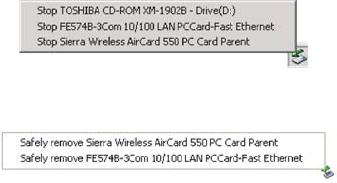
Section 3: Using the PCS Connection Card
3E: The Network Adapter Manager (Notebooks Only) 99
transmission speed. If you then want to take the computer to
another location, you can stop the Ethernet card (see below),
disconnect the cable to the Ethernet card, and Windows
2000/XP automatically begins routing network traffic through
the PCS Connection Card.
Since Windows 2000/XP has this enhanced method of
handling multiple PC Cards, the Network Adapter Manager
does not allow you to switch cards from the shortcut menu in
these operating systems.
In Windows 2000/XP you can control which card is the
primary card by stopping the cards you do not want to use.
To s top a car d:
1. Click the PC Card icon in the status area.
2. A listing of active cards is displayed.
Windows 2000
Windows XP
3. Click the card you want to stop.
On-Line Help and Version Information
To display on-line help for the Network Adapter Manager:
1. Right click the Network Adapter Manager status area icon.
2. Select Help from the shortcut menu.
To display version information for the Network Adapter
Manager:
1. Right click the Network Adapter Manager status area icon.
2. Select About Network Adapter Manager from the menu.
Closing the Network Adapter Manager
To close the Network Adapter Manager:
1. Right click the Network Adapter Manager status area icon.
2. Select Exit from the shortcut menu.
100

Section 3: Using the PCS Connection Card
3F: Troubleshooting Tips (Notebook PC) 101
Section 3F
Troubleshooting Tips
(Notebook PC)
In This Section
ᮣProblem Causes and Solutions
ᮣReinstalling the PCS Connection Card Driver
ᮣResolving Resource Conflicts
his section provides assistance in diagnosing and solving
many common problems you may experience while using
your PCS Connection Card with your notebook PC.
T

Section 3: Using the PCS Connection Card
102 3F: Troubleshooting Tips (Notebook PC)
Problem Causes and Suggestions
When properly installed, the PCS Connection Card is a highly
reliable product. Most problems are caused by one of these
issues:
ᮣThe wrong driver has been installed.
ᮣSystem resources required by the card are in use by other
devices.
ᮣNetwork coverage is not available (either because you are
outside the coverage area, or because of an account or
network problem).
This section describes how to diagnose and solve these and
other problems. If, after reading this section, you are unable
to resolve a problem, please visit www.sprintpcs.com or contact
PCS Customer Service Solutions at 1-888-211-4PCS (4727).
Error: Searching for PCS Connection Card...
The PCS Connection Manager Software displays this
message: “Searching for PCS Connection Card….
Error: Splash Screen is Frozen
The splash screen of the PCS Connection Manager Software
is frozen.
Possible Causes Suggestions
a. The card is not completely
inserted into the PC Card
slot.
b. The wrong driver is
installed for the card.
c. There is a resource conflict.
a. Eject and reinsert the card.
b. See "Reinstalling the
PCS Connection Card Driver" on
page 105“.
c. See "Resolving Resource
Conflicts" on page 111.
Possible Causes Suggestions
•If you are unable to resolve
this problem by restarting
your PC, you may have a
resource conflict.
•See "Resolving Resource
Conflicts" on page 111.

Section 3: Using the PCS Connection Card
3F: Troubleshooting Tips (Notebook PC) 103
Error: When Clicking the Keypad, Nothing Happens
Error: Not In Service
The PCS Connection Manager Software displays the message
“Not in service”.
Error: Not able to prepare data services (Windows 98 and 2000)
The PCS Connection Manager Software displays the message
“Unable to prepare data services.”.
Possible Causes Suggestions
•KeyGuard is on. •Turn KeyGuard off. See page 74.
Possible Causes Suggestions
Inadequate signal strength may
occur for any of these reasons:
a. You are outside the Sprint
Nationwide PCS Network.
b. Your antenna is not
attached or is pointed in
the wrong direction.
c. You may be inside a
building or near a structure
that is causing radio
interference.
a. Verify that you are within the
Sprint Nationwide PCS Network.
Coverage maps are available at
www.sprintpcs.com.
b. Ensure your antenna is properly
attached and is perpendicular to
the card. Re-orient your antenna.
c. Change your location.
Possible Causes Suggestions
•The modem was unable to
access to the IOTA server to
obtain data account param-
eters for you. This may be
due to poor signal strength,
or the IOTA server is not
responding.
•Confirm you have sufficient signal
strength. Try the actions listed
above for “Not In Service”.
•Contact Sprint for assistance.

Section 3: Using the PCS Connection Card
104 3F: Troubleshooting Tips (Notebook PC)
Error: Connection Seems Slow
When you have a both a PCS Connection Card and an
AirCard 300 in your computer, the data connection seems
quite slow.
Error: Connection Gets Dropped (Windows 2000 and XP)
When attempting a data connection with PCS Connection
Manager, the connection gets dropped as soon as it is
established (the status goes from “Authenticating” and
“Authenticated” back to “Ready to Connect”).
Possible Causes Suggestions
Under some operating systems, if both
cards are inserted, then the path that the
Internet Protocol (IP) traffic will take is
not predictable. If the data gets routed
through the AirCard 300, you will
experience slower data transfer rates.
Before you use the
PCS Connection Card, eject
the AirCard 300 from your
computer.
Possible Causes Suggestions
The connection
properties are not
optimal.
1. Windows XP: Click Start > Connect To > 1xRTT
(High-Speed).
Windows 2000: Click Start > Settings >
Network and Dial-Up Connections > 1xRTT (High-
Speed).
2. In the window that appears, click Properties.
3. Click the Networking tab.
4. Click Settings.
5. Ensure that Enable LCP Extensions and Negotiate
multi-link for single link connections are not
selected.
6. Click OK.

Section 3: Using the PCS Connection Card
3F: Troubleshooting Tips (Notebook PC) 105
Reinstalling the PCS Connection Card Driver
There is a PCS Connection Card driver for each supported
Windows operating system. Unless the appropriate driver for
your version of Windows is installed, you will not be able to
establish a network connection with the card. This section
provides instructions on verifying that you have the correct
card driver installed.
Note: You must have the PCS Connection Card installation CD to complete
this procedure.
Windows 98 SE
To verify that the correct driver is installed:
ᮣLocate the existing driver
ᮣReplace the driver with the Windows 98 SE driver from
the PCS Connection Card installation CD.
Locating the Existing Driver
1. Close all Windows programs and open the Control Panel
by selecting Start > Settings > Control Panel.
2. Double click the System icon.
3. Click the Device Manager tab.
4. Locate the PCS Connection Card entries by using the “+”
signs to expand the listings. (For example, to see all the
installed modems, click the “+” sign to the left of
Modems.) The card should have 3 entries:
ᮣThe card should display under Multifunction adapters as
Sierra Wireless AirCard 550 PC Card Parent.
ᮣThe card should display under Modems as Sierra
Wireless AirCard 550 Modem.
ᮣThe card should display under Network adapters as
Sierra Wireless AirCard 550 Adapter.
If the listings above do not appear, identify the listing for
the PCS Connection Card by ejecting the card. This causes
the driver listing for the card to disappear from the list.
Reinsert the card again to cause the driver listing to reap-
pear. You can identify the entries for the PCS Connection
Card by observing which entries are affected when you
eject and reinsert the card.
Section 3: Using the PCS Connection Card
106 3F: Troubleshooting Tips (Notebook PC)
Replacing the Driver
1. If the installation CD is not already in your CD-ROM
drive, insert it. If the CD start-up menu appears, use the
exit option in the lower left corner of the screen to exit
the menu.
2. Under Network adapters, click the PCS Connection Card
entry.
3. Click the Properties button.
4. Click the Driver tab.
5. Click the Update Driver… button to launch the Update
Device Driver Wizard.
6. Click Next.
7. Select Display a list of all the drivers in a specific location, so
you can select the one you want and click Next.
8. Click the Have Disk… button to open the Install From
Disk window.
9. Enter d:\Drivers\Win98 where d is the drive letter for your
CD-ROM drive. Click OK.
10. Click OK.
11. Click Next.
12. Click Finish.
13. Click No when prompted to restart your PC.
14. In the Control Panel Device Manager window, select the
PCS Connection Card listing under Modem.
15. Repeat steps 3 to 12.
16. Restart your PC.
The correct driver should then be installed.
Windows 2000
To verify that the correct driver is installed:
ᮣLocate the existing driver
ᮣUpdate the driver
Locating the Driver
1. Close all Windows programs and open the Control Panel
by selecting Start > Settings > Control Panel.
2. If the card is not already inserted into your PC Card slot,
insert it.
3. Double click the System icon.
4. Click the Hardware tab.
5. Click the Device Manager… button.
Section 3: Using the PCS Connection Card
3F: Troubleshooting Tips (Notebook PC) 107
6. Locate the PCS Connection Card entries by using the “+”
signs to expand the listings. (For example, to see all the
installed modems, click the “+” sign to the left of
Modems.) The card should have 3 entries:
ᮣThe card should display under Multifunction adapters as
Sierra Wireless AirCard 550 PC Card Parent.
ᮣThe card should display under Modems as Sierra
Wireless AirCard 550 Modem.
ᮣThe card should display under Network adapters as
Sierra Wireless AirCard 550 Adapter.
If the listings above do not appear, identify the listing for
the PCS Connection Card by ejecting the card. This causes
the driver listing for the card to disappear from the list.
Reinsert the card again to cause the driver listing to reap-
pear. You can identify the entries for the PCS Connection
Card by observing which entries are affected when you
eject and reinsert the card.
Updating the Driver
1. If the installation CD is not already in your CD-ROM
drive, insert it. If the CD start-up menu appears, use the
exit option in the lower left corner of the screen to exit
the menu.
2. Right click Sierra Wireless AirCard 550 PC Card Parent (or the
card listing under Multifunction adapters) to display a pop-up
menu.
3. Select Properties in the pop-up menu to open the
Properties window.
4. Click the Driver tab.
5. Click the Update Driver… button to open the Upgrade
Device Driver Wizard.
6. Click Next on the first window of the Found New
Hardware Wizard to proceed to the next window.
7. Select Display a list of the known drivers for this device so that
I can choose a specific driver and click Next.
8. Click the Have Disk… button.
9. Enter d:\Drivers\Win2k, where d is the drive letter for your
CD-ROM drive, and click OK to proceed.
10. Click Next.
11. If the Digital Signature Not Found window displays, click
Yes.
12. Click Finish to proceed. Repeat steps 6 to 12 as prompted.
Section 3: Using the PCS Connection Card
108 3F: Troubleshooting Tips (Notebook PC)
If you are prompted to restart your PC, click Yes. Otherwise,
restart your PC from the Start menu. (You must restart your
PC to complete the driver installation.) The correct driver is
then installed.
Windows Me
To verify that the correct driver is installed:
ᮣLocate the existing driver
ᮣReplace the driver with the Windows Me driver from the
PCS Connection Card installation CD.
Locating the Existing Driver
1. Open the Control Panel by selecting Start > Settings >
Control Panel.
2. If the System icon is not in the window, view all Control
Panel options.
3. Double click the System icon.
4. Click the Device Manager tab.
5. Locate the PCS Connection Card entries by using the “+”
signs to expand the listings. (For example, to see all the
installed modems, click the “+” sign to the left of
Modems.) The card should have 3 entries:
ᮣThe card should display under Multifunction adapters as
Sierra Wireless AirCard 550 PC Card Parent.
ᮣThe card should display under Modems as Sierra
Wireless AirCard 550 Modem.
ᮣThe card should display under Network adapters as
Sierra Wireless AirCard 550 Adapter.
If the listings above do not appear, identify the listing for
the PCS Connection Card by ejecting the card. This causes
the driver listing for the card to disappear from the list.
Reinsert the card again to cause the driver listing to reap-
pear. You can identify the entries for the PCS Connection
Card by observing which entries are affected when you
eject and reinsert the card.
Replacing the PCS Connection Card Driver
1. If the installation CD is not already in your CD-ROM
drive, insert it. If the CD start-up menu appears, use the
exit option in the lower left corner of the screen to exit
the menu.
Section 3: Using the PCS Connection Card
3F: Troubleshooting Tips (Notebook PC) 109
2. Click to select Sierra Wireless AirCard 550 PC Card Parent (or
the PCS Connection Card listing under Multi-function
adapters).
3. Click the Properties button.
4. Click the Driver tab.
5. Click the Update Driver button to launch the Update
Device Driver Wizard.
6. Select the Specify the location of the driver (Advanced) radio
button, and click Next to proceed to the next window.
7. Select the Search for a better driver than the one your device
is using now. (Recommended) radio button. Click the check
boxes so that the Removable Media check box is NOT
checked and Specify a location IS checked. Enter
d:\Drivers\WinMe where d is the driver letter for your CD-
ROM drive and click Next.
8. If a window appears stating that you are already using the
best driver for this device, click the Install one of the other
drivers radio button and click the View List… button.
9. Ensure the line selected in the Select Other Drivers
window is d:\DRIVERS\WINME\… (where d is your CD-ROM
drive letter) and click OK.
10. Click Next.
11. Click Finish and repeat steps 6 to 11 as prompted.
12. If you are prompted to restart you computer, click Yes.
Otherwise restart your PC from the Start menu.
The correct driver is then installed.
Section 3: Using the PCS Connection Card
110 3F: Troubleshooting Tips (Notebook PC)
Windows XP
To verify that the correct driver is installed:
ᮣUninstall the existing driver
ᮣInstall the Windows XP driver from the PCS Connection
Card installation CD.
Uninstalling the Existing Driver
1. Open the Control Panel by selecting Start > Control Panel.
2. If “Pick a category” is displayed, select Switch to Classic
View.
3. Double click the System icon.
4. Click the Hardware tab.
5. Click the Device Manager button.
6. Locate the PCS Connection Card entries by using the “+”
signs to expand the listings. (For example, to see all the
installed modems, click the “+” sign to the left of
Modems.) The card should have 3 entries:
ᮣThe card should display under Multifunction adapters as
Sierra Wireless AirCard 550 PC Card Parent.
ᮣThe card should display under Modems as Sierra
Wireless AirCard 550 Modem.
ᮣThe card should display under Network adapters as
Sierra Wireless AirCard 550 Adapter.
If the listings above do not appear, identify the listing for
the PCS Connection Card by ejecting the card. This causes
the driver listing for the card to disappear from the list.
Reinsert the card again to cause the driver listing to reap-
pear. You can identify the entries for the PCS Connection
Card by observing which entries are affected when you
eject and reinsert the card. Right click Sierra Wireless Air-
Card 550 PC Card Parent (or the PCS Connection Card listing
under Multifunction adapters) to display a pop-up menu.
7. Select Uninstall in the pop-up menu.
8. Confirm that you want to uninstall the device by clicking
OK.
The PCS Connection Card listings should be removed.

Section 3: Using the PCS Connection Card
3F: Troubleshooting Tips (Notebook PC) 111
Installing the Windows XP PCS Connection Card Driver
1. If the installation CD is not already in your CD-ROM
drive, insert it. If the CD start-up menu appears, use the
exit option in the lower left corner of the screen to exit
the menu.
2. Eject and reinsert the PCS Connection Card to launch the
Found New Hardware Wizard.
3. Select Install from a list or specific location (Advanced) on
the first window of the Found New Hardware Wizard and
click Next to proceed.
4. Select the Search for the best driver in these locations radio
button, and the Include this location in the search check
box, then enter d:\Drivers\WinXP where d is the drive letter
of your CD-ROM drive. Click Next to proceed to the next
window.
5. If a warning appears stating that PCS Connection Card
has not passed Windows Logo testing, click Continue
Anyway.
6. Click Finish and repeat steps 1 to 5 as prompted.
The correct driver is then installed.
Resolving Resource Conflicts
Note: You require your PCS Connection Card installation CD to complete
this procedure.
The PCS Connection Card requires these system resources:
ᮣ1 IRQ
ᮣ40 bytes of I/O space
ᮣ1 communications port
If these resources are not available to the card, you have a
resource conflict. If another PC Card is installed, you may be
able to free the necessary resources simply by ejecting the
other card. Otherwise, you may need to disable another
device (such as an internal modem, infrared device, or
network card) to resolve the resource conflict. This section
explains how to disable other devices.
Section 3: Using the PCS Connection Card
112 3F: Troubleshooting Tips (Notebook PC)
Windows 98 SE
To resolve a resource conflict in Windows 98 SE:
ᮣDisable a device (internal modem, infrared device, or
network card)
ᮣUninstall and reinstall the PCS Connection Card driver
Disabling an Internal Modem, Infrared Device, or Network Card
1. Close all Windows programs and open the Control Panel
by selecting Start > Settings > Control Panel.
2. Double click the System icon.
3. Click the Device Manager tab.
4. Locate the device that you want to disable:
ᮣIf you want to disable an internal modem, expand the
Modem tree by clicking the “+” sign to its left. Double
click the internal modem that you wish to disable.
ᮣIf you want to disable an infrared device, expand the
Infrared Devices tree by clicking the “+” sign to its left.
Double click the infrared device that you wish to
disable.
ᮣIf you want to disable a network card, expand the
Network Adapters tree by clicking the “+” sign to its
left. Double click the network card you wish to
disable.
5. In the window that appears, in the Device Usage section,
click the check box labeled Disable in this hardware profile
so that the box is checked, and click OK.
Uninstalling and Reinstalling the PCS Connection Card Driver
1. If the installation CD is not already in your CD-ROM
drive, insert it. If the CD start-up menu appears, use the
exit option in the lower left corner of the screen to exit
the menu.
2. If the card is not already inserted into a PC Card slot,
insert it.
3. In the Control Panel Device Manager window, open the
Multifunction Adapters tree by clicking the “+” sign to its
left.
4. Highlight the Sierra Wireless AirCard 550 PC Card Parent.
5. Click the Remove button.
6. Confirm that you want to remove the driver by clicking
OK.
7. Reinsert the card into your PC Card slot.
Section 3: Using the PCS Connection Card
3F: Troubleshooting Tips (Notebook PC) 113
Windows should then reinstall the driver for your
PCS Connection Card. If the Add New Hardware Wizard is
launched, follow the installation below.
1. Click Next on the first window of the Add New Hardware
Wizard to proceed to the next window.
2. Select Search for the best driver for your device
(Recommended) and click Next to proceed to the next
window.
3. Ensure that Specify a location is the only check box
selected, enter d:\Drivers\Win98 where d is the drive letter
for your CD-ROM drive, and click Next to proceed.
4. Click Next on the window that displays the file name.
5. Click Finish and repeat steps 1 to 4 as prompted.
6. If you are prompted to restart your PC, click Yes.
Otherwise, restart your PC from the Start menu. (You
must restart your PC to complete the driver installation.)
Windows 2000
To resolve a resource conflict in Windows 2000:
ᮣDisable a device (internal modem, infrared device, or
network card
ᮣUninstall and reinstall the PCS Connection Card driver
Disabling an Internal Modem, Infrared Device, or Network Card
1. Close all Windows programs and open the Control Panel
by selecting Start > Settings > Control Panel.
2. Double click the System icon.
3. Click the Hardware tab.
4. Click the Device Manager button.
5. Locate the device that you want to disable:
ᮣIf you want to disable an internal modem, expand the
Modem tree by clicking the “+” sign to its left.
ᮣIf you want to disable an infrared device, expand the
Infrared Devices tree by clicking the “+” sign to its left.
ᮣIf you want to disable a network card, expand the
Network Adapters tree by clicking the “+” sign to its
left.
6. Right click the device you want to disable, choose Disable
from the pop-up menu that appears and click OK.
Section 3: Using the PCS Connection Card
114 3F: Troubleshooting Tips (Notebook PC)
Updating the Driver
1. If the installation CD is not already in your CD-ROM
drive, insert it. If the CD start-up menu appears, use the
exit option in the lower left corner of the screen to exit
the menu.
2. If the card is not already inserted into your PC Card slot,
insert it.
3. In the Control Panel Device Manager window, expand the
Multifunction adapters tree by clicking the “+” sign to its
left.
4. Right click Sierra Wireless AirCard 550 PC Card Parent.
5. Select Properties in the pop-up menu to open the
Properties window.
6. Click the Driver tab.
7. Click the Update Driver… button to open the Upgrade
Device Driver Wizard.
8. Click Next on the first window of the Found New
Hardware Wizard to proceed to the next window.
9. Select Display a list of the known drivers for this device so that
I can choose a specific driver and click Next.
10. Click the Have Disk… button.
11. Enter d:\Drivers\Win2k, where d is the drive letter for your
CD-ROM drive, and click OK to proceed.
12. Click Next.
13. If the Digital Signature Not Found window appears, click
Yes.
14. Click Finish to proceed. Repeat steps 8 to 13 as prompted.
If you are prompted to restart your PC, click Yes. Otherwise,
restart your PC from the Start menu. (You must restart your
PC to complete the driver installation and reassign the
resources.)
Section 3: Using the PCS Connection Card
3F: Troubleshooting Tips (Notebook PC) 115
Windows Me
To resolve a resource conflict in Windows Me:
ᮣDisable a device (internal modem, infrared device, or
network card
ᮣUninstall and reinstall the PCS Connection Card driver
Disabling an Internal Modem, Infrared Device, or Network Card
1. Close all Windows programs and open the Control Panel
by selecting Start > Settings > Control Panel.
2. If the System icon is not in the window, click view all
Control Panel options.
3. Double click the System icon.
4. Click the Device Manager button.
5. Locate the device that you want to disable:
ᮣIf you want to disable an internal modem, expand the
Modem tree by clicking the “+” sign to its left.
ᮣIf you want to disable an infrared device, expand the
Infrared Devices tree by clicking the “+” sign to its left.
ᮣIf you want to disable a network card, expand the
Network Adapters tree by clicking the “+” sign to its
left.
6. Click to select the device you want to disable, and the
Properties button.
7. Click to check the Disable in this hardware profile check
box in the Device usage section of the window and click
the OK button.
Uninstalling and Reinstalling the PCS Connection Card Driver
1. If the installation CD is not already in your CD-ROM
drive, insert it. If the CD start-up menu appears, use the
exit option in the lower left corner of the screen to exit
the menu.
2. If the card is not already inserted into a PC Card slot,
insert it.
3. In the Control Panel Device Manager window, expand the
Multifunction Adapters tree by clicking the “+” sign to its
left.
4. Click the Sierra Wireless AirCard 550 PC Card Parent and
click the Remove button.
5. Confirm that you want to remove the device by clicking
OK.
6. Close all windows and restart your PC.
Section 3: Using the PCS Connection Card
116 3F: Troubleshooting Tips (Notebook PC)
7. If you are prompted for a file when the PC restarts, enter
d:\Drivers\WinMe where d is the drive letter of your CD-
ROM drive and click OK to proceed.
8. If the Add New Hardware Wizard appears, follow these
instructions:
ᮣClick Specify the location of the driver (Advanced) on the
first window of the Add New Hardware Wizard and
click Next to proceed.
ᮣSelect the Search for the best driver for your device radio
button, and the Specify a location check box, then
enter d:\Drivers\WinMe where d is the drive letter of
your CD-ROM drive. Click Next to proceed to the next
window.
ᮣIf prompted, “What would you like to install?”, select
The updated software (Recommended) and click Next.
ᮣClick Next on the window that displays a file name.
ᮣClick Finish and repeat steps 1 to 4 as prompted.
ᮣIf you are prompted to restart your PC, click Yes.
Otherwise, restart your PC from the Start menu. (You
must restart your PC to complete the driver
installation.)
Windows XP
To resolve a resource conflict in Windows XP:
ᮣDisable a device (internal modem, infrared device, or
network card)
ᮣUninstall and reinstall the PCS Connection Card driver
Disabling an Internal Modem, Infrared Device, or Network Card
1. Close all Windows programs and open the Control Panel
by selecting Start > Settings > Control Panel.
2. Double click the System icon.
3. Click the Hardware tab.
4. Click the Device Manager button.
5. Locate the device that you want to disable:
ᮣIf you want to disable an internal modem, expand the
Modem tree by clicking the “+” sign to its left.
ᮣIf you want to disable an infrared device, expand the
Infrared Devices tree by clicking the “+” sign to its left.
ᮣIf you want to disable a network card, expand the
Network Adapters tree by clicking the “+” sign to its
left.
Section 3: Using the PCS Connection Card
3F: Troubleshooting Tips (Notebook PC) 117
6. Right click the device you want to disable, choose Disable
from the pop-up menu that appears and click OK.
Uninstalling and Reinstalling the PCS Connection Card Driver
1. If the installation CD is not already in your CD-ROM
drive, insert it. If the CD start-up menu appears, use the
exit option in the lower left corner of the screen to exit
the menu.
2. If the card is not already inserted into a PC Card slot,
insert it.
3. In the Control Panel Device Manager window, expand the
Multifunction Adapters tree by clicking the “+” sign to its
left.
4. Right click the Sierra Wireless AirCard 550 PC Card Parent.
5. Click Uninstall from the pop-up menu and click OK.
6. Eject and reinsert the PCS Connection Card to launch the
Found New Hardware Wizard.
7. Select Install from a list or specific location (Advanced) and
click Next.
8. Select the Search for the best driver in these locations radio
button, and the Include this location in the search check
box, then enter d:\Drivers\WinXP where d is the drive letter
of your CD-ROM drive. Click Next to proceed to the next
window.
9. If a window appears prompting you to select the best
match for your hardware from a list, select the listing that
shows, in the Location column,
d:\drivers\winxp\netac550.inf (where d is your CD-ROM
driver letter). Click Next.
10. If a warning appears stating that the PCS Connection
Card has not passed Windows Logo testing, click Continue
Anyway.
11. Click Finish and repeat steps 7 to 11 as prompted.
12. If you are prompted to restart your PC, click Yes.
Otherwise, restart your PC from the Start menu. (You
must restart your PC to complete the driver installation
and reassign the resources.)
The driver should then be reinstalled, and the resource
conflict resolved.
118

Section 3: Using the AirCard
3G: Troubleshooting Tips (Handheld / Pocket PC) 119
Section 3G
Troubleshooting Tips
(Handheld / Pocket PC)
In This Section
ᮣProblem Causes and Suggestions
ᮣUninstalling the PCS Connection ManagerSM Software
his section provides assistance in diagnosing and solving
many common problems you may experience while using
your PCS Connection CardTM with your Handheld or Pocket PC.
T

Section 3: Using the AirCard
120 3G: Troubleshooting Tips (Handheld / Pocket PC)
Problem Causes and Suggestions
When properly installed, the PCS Connection Card is a highly
reliable product. Most problems are caused by one of these
issues:
ᮣThe wrong driver has been installed.
ᮣNetwork coverage is not available (either because you are
outside the coverage area, or because of an account or
network problem).
This section describes how to diagnose and solve these and
other problems. If, after reading this section, you are unable
to resolve a problem, please visit www.sprintpcs.com or contact
PCS Customer Service Solutions at 1-888-211-4PCS (4727).
Error: ActiveSync Does Not Prompt that There is Software
to Download
You have installed the PCS Connection Manager Software to
the host and connected the Handheld/Pocket PC to the host.
ActiveSync launches but does NOT prompt that there is
software to download, so you are unable to complete the
installation process.
Error: When Tapping the Keypad, Nothing Happens
Possible Causes Suggestions
There was a failure in the host
installation process or
ActiveSync has failed to detect
that there is software to
download.
Uninstall the software and start the
installation process again. For
instructions, see ‘Uninstalling the
PCS Connection Manager Software”
on page 123.
Possible Causes Suggestions
•KeyGuard is on. •Turn KeyGuard off. See page 74.

Section 3: Using the AirCard
3G: Troubleshooting Tips (Handheld / Pocket PC) 121
Error: Searching for PCS Connection Card...
The PCS Connection Manager Software displays the message
“Searching for PCS Connection Card….”
Error: Not able to prepare data services
The PCS Connection Manager Software displays the message
“Unable to prepare data services.”.
Possible Causes Suggestions
a. The card is not completely
inserted into the PC Card
slot.
b. The wrong driver is
installed for the card.
c. The battery of your Pocket
PC or its expansion pack is
low.
a. Eject and reinsert the card.
b. Uninstall the PCS Connection
Card Software and reinstall it.
For instructions on removing the
software, see ‘Uninstalling the
PCS Connection Manager
Software” on page 123. To
reinstall the software, see
“Installing the PCS Connection
Manager Software” on page 26.
c. Ensure your Pocket PC and its
expansion pack are fully charged.
Possible Causes Suggestions
•The modem was unable to
access to the IOTA server to
obtain data account param-
eters for you. This may be
due to poor signal strength,
or the IOTA server is not
responding.
•Confirm you have sufficient signal
strength. Try the actions listed
above for “Not In Service”.
•Contact Sprint for assistance.

Section 3: Using the AirCard
122 3G: Troubleshooting Tips (Handheld / Pocket PC)
Error: Not In Service
The PCS Connection Manager displays the message “Not in
service”.
Error: Connection Seems Slow
(Pocket PCS only:) When you have both a PCS Connection
Card and an AirCard 300 in your dual-card PCMCIA jacket
accessory, the data connection seems quite slow.
Possible Causes Suggestions
Inadequate signal strength may
occur for any of these reasons:
a. You are outside the Sprint
Nationwide PCS Network.
b. Your antenna is not
attached or is pointed in
the wrong direction.
c. You may be inside a
building or near a structure
that is causing radio
interference.
a. Verify that you are within the
Sprint Nationwide PCS Network.
Coverage maps are available at
www.sprintpcs.com.
b. Ensure your antenna is properly
attached. Re-orient your antenna.
c. Change your location.
Possible Causes Suggestions
•If both cards are inserted,
then the path that the
Internet Protocol (IP) traffic
will take is not predictable.
If the data gets routed
through the AirCard 300,
you will experience slower
data transfer rates.
•Eject the AirCard 300 from your
PCMCIA jacket accessory
before you use the
PCS Connection Card.
Section 3: Using the AirCard
3G: Troubleshooting Tips (Handheld / Pocket PC) 123
Uninstalling the PCS Connection Manager
Software
To uninstall the PCS Connection Manager Software from the host PC:
1. If your Handheld/Pocket PC is connected to the host,
disconnect it.
2. On the host, open the Control Panel by selecting Start >
Settings > Control Panel.
3. Double click the Add/Remove Programs icon to open the
Add/Remove Programs window.
4. Click to select Sierra Wireless AirCard 550 Pocket PC….
5. Double click the Add/Remove button.
6. Confirm that you want to delete the program by clicking
OK.
7. Click Finish.
To remove the software from a Pocket PC:
1. Eject the PCS Connection Card if it is inserted in your
PCMCIA jacket (and the jacket is attached).
2. Tap Start > Settings.
3. Tap the System tab.
4. Tap the Remove Programs icon.
5. Tap Sierra Wireless Inc AirCard 550… and tap the Remove
button.
6. Confirm that you want to remove the program by tapping
Yes.
To remove the software from a Handheld PC:
1. Eject the PCS Connection Card if it is inserted in your PC
Card slot.
2. Open the Control Panel by selecting Start > Settings >
Control Panel.
3. Double tap the Remove Programs icon.
4. Select Sierra Wireless Inc AirCard 550 Handheld and tap the
Remove button.
5. Confirm that you want to delete the software by tapping
Yes.
To reinstall the software, follow the instructions starting on
page 26.
124
Section 4
PCS Vision 125
Section 4
PCS Vision
126

Section 4: PCS Vision
4A: PCS Vision 127
Section 4A
PCS VisionSM
In This Section
ᮣWeb
ᮣMessaging
ᮣPCS Business ConnectionSM
CS VisionSM brings you clarity you can see and hear with
always-on, advanced multimedia services. These features,
including email, Internet browsing and PCS Business
ConnectionSM, are easy to learn and use. Clearly. It’s a whole
new way to look at wireless.
P

Section 4: PCS Vision
128 4A: PCS Vision
Browsing the Web With Your
PCS Connection Card
Launching the Web
To l aun ch t he We b:
ᮣFrom the card’s main menu, highlight Web and select
Launch.
Your User Name
When you buy a PCS Connection Card and sign up for
service, you're automatically assigned a User name. Then,
when you use PCS Vision services, your User name is
submitted to identify you to the enhanced Sprint Nationwide
PCS Network. The User name is also useful as an address for
email and instant messaging, as a way to personalize Internet
services, and as an online virtual identity.
A User name is typically based on the customer's name and a
number, followed by “@sprintpcs.com.” For example, the
third John Smith to sign up for PCS Vision Services might
have jsmith003@sprintpcs.com as his User name. If you want
a particular User name, you can visit www.sprintpcs.com and get
the name you want – as long as nobody else has it!
Note: If you already have a PCS Mail User name, that will automatically
become your PCS Vision User name.
Your User name will be automatically programmed into your
PCS Connection Card. You don't have to enter it.

Section 4: PCS Vision
4A: PCS Vision 129
Messaging
Now you can chat and send and receive email and instant
messages on select PCS Connection Cards. When you chat,
you can have a conversation without talking. Join in a Web-
based chat room to exchange information on a specific topic
or read conversations that others have posted – even launch
a one-on-one chat for a more in-depth conversation.
PCS Messages
These appear on your screen as Page/Text and include
numeric messages and PCS Messages.
Signing Up for Web Updates
With Web Updates, you can have news and information sent
directly to your PCS Connection Card at the times you
choose.
To select the information you want sent to your card:
1. From your computer, log on to the Internet.
2. Go to the site from which you want to receive
information. A few of the sites you can visit are America
Online®, Yahoo!®, MSN® and eBay®. (The location where
you request updates within each site will vary.)
3. Where indicated on the site, input your 10-digit
PCS Phone Number followed by
“@messaging.sprintpcs.com.” For example:
5551234567@messaging.sprintpcs.com.
Upon completing the registration process, you should begin
receiving updates on your card as requested.

130
PCS Business ConnectionSM
Personal Edition
PCS Business ConnectionSM Personal Edition is designed to
offer secure wireless access to both Microsoft® Outlook® and
Lotus Notes®.
PCS Business Connection Personal Edition delivers the
following features:
ᮣBusiness email access: Read, reply to, forward, delete and
compose your company email.
ᮣCompany directory and contacts: Search, view, call, and
email contacts from your company's directory. Do all this
and add/edit your personal contacts.
ᮣWork calendar: Accept and reject meetings, view daily
summaries and details, navigate to various dates.
ᮣFiles/information on your PC: Browse folders, download and
view documents from any device using a PC browser or
Pocket Internet Explorer.
To use PCS Business Connection Personal Edition, install
Business Connection Personal Edition software on your work
PC. This allows data to be securely retrieved in real-time by
your wireless device when connected to the Sprint
Nationwide PCS Network. There is a monthly charge for
PCS Business Connection, and usage charges will also apply.
When your work PC isn't on, you can share connections with
your co-workers so that you always have access to your email,
calendar, and contacts. Your data remains secure behind the
corporate firewall and any changes you make on your
wireless device are instantly updated on your company server
without the need to synchronize.
Additional Business Connection solutions are available to
your company. For more details, visit
businessconnection.sprintpcs.com.

Section 4: PCS Vision
4A: PCS Vision 131
PCS Vision FAQs
How will I know when my card is ready for PCS Vision Service?
Your user name (for example, bsmith001@sprintpcs.com)
will appear on the display screen.
How do I sign-in for the first time?
You are automatically signed in to PCS Vision services when
you turn on your PCS_Connection Card.
How do I know when my card is connected to PCS Vision
Services?
Your card automatically connects when PCS Vision
Service is used or an incoming message arrives. Your
screen will also display the signal strenth icon.
(Connecting takes about 10-12 seconds.)
When is my data connection active?
Your connection is active when data is being
transferred. Incoming calls go directly to voicemail.
When active, the data indicator appears on the
display.
When is my data connection dormant?
If no data is received for 10 seconds, the connection
goes dormant. When the connection is dormant,
voice calls are allowed. (The connection may become
active again quickly.) While dormant, the data icon
appears grey. If no data is received for an extended
period of time, the connection will terminate.
Can I sign out of data services?
You can sign out without turning off your card, however you
will not be able to browse the Web or use other PCS Vision
services. While signed out, you can still place or receive
phone calls, check voicemail, and use other voice services.
You may sign in again at any time.

Section 4: PCS Vision
132 4A: PCS Vision
How can I optimize my settings to achieve faster speeds and send
and receive less data while dialing into my corporate network?
For optimized results, work in “Offline” mode and
synchronize periodically to send and receive corporate email.
Also, save/drag-and-drop attachments to a desktop folder
rather than double-clicking prior to opening. For more
detailed information, access the Microsoft whitepaper at http:/
/www.microsoft.com/office/outlook/evaluation/perform.doc.
Section 5
Technical Specifications and Regulatory Information 133
Section 5
Technical Specifications
and
Regulatory Information
134

Section 5: Technical Specifications
5A: Technical Specifications 135
Section 5A
Technical Specifications
In This Section
ᮣLED Operation
ᮣRadio Frequency and Electrical Specifications
ᮣEnvironmental Specifications
his section outlines LED operation and the technical and
environmental specifications of your new PCS Connection
Card.
T
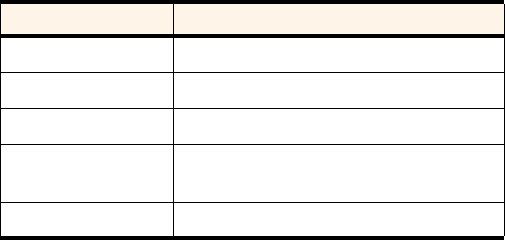
Section 5: Technical Specifications
136 5A: Technical Specifications
LED Operation
The PCS Connection Card has a single red/green LED on the
antenna end of the card. The LED operates as follows:
*Both red and green are lit.
Table 1: LED Operation
LED Behavior Indicates
Solid amber* The card is powering up.
Blinking amber The card is searching for a channel.
Solid green A call is in progress.
Blinking green The card has acquired a channel and is in idle
mode (no call is in progress).
Solid red An error has occurred.

Section 5: Technical Specifications
5A: Technical Specifications 137
Radio Frequency and Electrical Specifications
Environmental Specifications
Table 2: Radio Frequency & Electrical Specifications
Approvals Compliant with:
IS-95A, IS-95B, IS-98D, IS-707A, IS707A-1,
CDMA Developers Group
FCC
Industry Canada
Voltage +5 Vdc from PCMCIA Slot
Current Maximum: 680 mA
Typical: 150 mA
Transmitter power 200 mW (+23 dBm)
Transmit PCS: 1850 to 1910 MHz
Cellular: 824 to 849 MHz
Receive PCS: 1930 to 1990 MHz
Cellular: 869 to 894 MHz
Channel spacing 1.25 MHz
Frequency stability ± 150 Hz
Table 3: Environmental Specifications
Operating
temperature
-30 to +60 °C (ambient, outside PCMCIA
enclosure)
Storage
temperature
-30 to +85 °C
Humidity 95%, non-condensing
Vibration 15 g peak 10 to 2000 Hz (non-operating)
Drop 30” (76. cm) on to vinyl covered concrete
138

Section 5: Technical Specifications and Regulatory Intormation
5B: Regulatory Information 139
Section 5B
Regulatory Information
In This Section
ᮣWarning (EMI) - US FCC Information
ᮣWarning (EMI) - Canada
his section outlines important regulatory notices concerning your new
PCS Connection Card.
T
Section 5: Technical Specifications and Regulatory Intormation
140 5B: Regulatory Information
Regulatory Notices
This device complies with Part 15 of the FCC Rules. Operation of this
device is subject to the condition that this device does not cause harmful
interference. FCC guidelines stipulate that the antenna should be more
than 17mm (0.68”) from all persons.
FCC ID: N7NACRD555
Where appropriate, the use of the equipment is subject to the following
conditions:
CAUTION Unauthorized modifications or changes not expressly
approved by Sierra Wireless, Inc. could void compliance with regulatory
rules, and thereby your authority to use this equipment.
WARNING (EMI) – United States FCC Information – This equipment
has been tested and found to comply with the limits pursuant to Part 15
of the FCC Rules. These limits are designed to provide reasonable
protection against harmful interference in an appropriate installation.
This equipment generates, uses, and can radiate radio frequency energy
and, if not installed and used in accordance with the instructions, may
cause harmful interference to radio communication. However, there is
no guarantee that interference will not occur in a particular installation.
If this equipment does cause harmful interference to radio or television
reception, which can be determined by turning the equipment off and
on, the user is encouraged to try to correct the interference by one or
more of the following measures:
ᮣReorient or relocate the receiving antenna
ᮣIncrease the separation between the equipment and receiver
ᮣConnect the equipment into an outlet on a circuit different from that
to which the receiver is connected
ᮣConsult the dealer or an experienced radio/TV technician for help
WARNING (EMI) – Canada – This digital apparatus does not exceed the
Class B limits for radio noise emissions from digital apparatus as set out
in the interference causing equipment standard entitled “Digital
Apparatus”, ICES-003 of the Department of Communications.
Section 5: Technical Specifications and Regulatory Intormation
5B: Regulatory Information 141
Cet appareil numérique respecte les limites de bruits radioélectriques
applicables aux appareils numériques de Classe B prescrites dans la
norme sur le matériel brouilleur: “Appareils Numériques”, NMB-003
édictée par le ministre des Communications.
If you have purchased this product under a United States Government
contract, it shall be subject to restrictions as set forth in subparagraph
(c)(1)(ii) of Defense Federal Acquisitions Regulations (DFARs) Section
252.227-7013 for Department of Defense contracts, and as set forth in
Federal Acquisitions Regulations (FARs) Section 52.227-19 for civilian
agency contracts or any successor regulations. If further government
regulations apply, it is your responsibility to ensure compliance with such
regulations.
142
Section 6
Safety Information and Terms & Conditions 143
Section 6
Safety Information
and
Terms & Conditions
144

Section 6: Safety Information and Terms & Conditions
6A: Safety and Notices 145
Section 6A
Safety and Notices
In This Section
ᮣImportant Notice
ᮣSafety and Hazards
ᮣLimitations of Liability
his section outlines important safety guidelines and liability
statements concerning your new PCS Connection CardTM.
T

Section 6: Safety Information and Terms & Conditions
146 6A: Safety and Notices
Important Notice
Because of the nature of wireless communications,
transmission and reception of data can never be guaranteed.
Data may be delayed, corrupted (i.e., have errors) or be
totally lost. Although significant delays or losses of data are
rare when wireless devices such as the PCS Connection Card
are used in a normal manner with a well-constructed network,
the PCS Connection Card should not be used in situations
where failure to transmit or receive data could result in
damage of any kind to the user or any other party, including
but not limited to personal injury, death, or loss of property.
Sierra Wireless, Inc. and its affiliates accept no responsibility
for damages of any kind resulting from delays or errors in
data transmitted or received using the PCS Connection Card,
or for failure of the PCS Connection Card to transmit or
receive such data.
Safety and Hazards
Do not operate the PCS Connection Card in areas where
blasting is in progress, where explosive atmospheres may be
present, near medical equipment, life support equipment, or
any equipment which may be susceptible to any form of
radio interference. In such areas, the PCS Connection Card
MUST BE POWERED OFF. The PCS Connection Card can
transmit signals that could interfere with this equipment.
Do not operate the PCS Connection Card in any aircraft,
whether the aircraft is on the ground or in flight. In aircraft,
the PCS Connection Card MUST BE POWERED OFF. When
operating, the PCS Connection Card can transmit signals that
could interfere with various onboard systems.
Note: Some airlines may permit the use of cellular phones while the
aircraft is on the ground and the door is open. PCS Connection Cards may
be used at this time.
The driver or operator of any vehicle should not operate the
PCS Connection Card while in control of a vehicle. Doing so
will detract from the driver or operator's control and
operation of that vehicle. In some states and provinces,
Section 6: Safety Information and Terms & Conditions
6A: Safety and Notices 147
operating such communications devices while in control of a
vehicle is an offence.
Limitation of Liability
The information in this manual is subject to change without
notice and does not represent a commitment on the part of
Sierra Wireless, Inc. or its affiliates. SIERRA WIRELESS, INC.
AND ITS AFFILIATES SPECIFICALLY DISCLAIM LIABILITY
FOR ANY AND ALL DIRECT, INDIRECT, SPECIAL, GENERAL,
INCIDENTAL, CONSEQUENTIAL, PUNITIVE OR EXEMPLARY
DAMAGES INCLUDING, BUT NOT LIMITED TO, LOSS OF
PROFITS OR REVENUE OR ANTICIPATED PROFITS OR
REVENUE ARISING OUT OF THE USE OR INABILITY TO USE
ANY SIERRA WIRELESS, INC. PRODUCT, EVEN IF SIERRA
WIRELESS, INC. AND/OR ITS AFFILIATES HAVE BEEN
ADVISED OF THE POSSIBILITY OF SUCH DAMAGES OR
THEY ARE FORESEEABLE OR FOR CLAIMS BY ANY THIRD
PARTY. NOTWITHSTANDING THE FOREGOING, IN NO
EVENT SHALL SIERRA WIRELESS, INC. AND/OR ITS
AFFILIATES’ AGGREGATE LIABILITY ARISING UNDER OR IN
CONNECTION WITH THE SIERRA WIRELESS PRODUCT,
REGARDLESS OF THE NUMBER OF EVENTS,
OCCURRENCES OR CLAIMS GIVING RISE TO LIABILITY, BE
IN EXCESS OF THE PRICE PAID BY THE PURCHASER FOR
THE SIERRA WIRELESS PRODUCT.

Section 6: Safety Information and Terms & Conditions
148 6A: Safety and Notices
Patents
Portions of this product are covered by some or all of the
following US patents: 5515013, 5617106, 5629960, 5682602,
5748449, 5845216, 5847553, 5878234, 5890057, 5929815,
6169884, 6191741, 6199168, 6339405, D367062, D372248,
D372701, D416857, D442170, D452495, D452496, and other
patents pending.
Licensed by QUALCOMM Incorporated under one or more of
the following United States Patents and/or their counterparts
in other nations:
4901307 5490165 5056109 5504773 5101501
5506865 5109390 5511073 5228054 5535239
5267261 5544196 5267262 5568483 5337338
5600754 5414796 5657420 5416797 5659569
5710784 5778338
Copyright
©2002 Sierra Wireless, Inc. All rights reserved.
Trademarks
Sierra Wireless, the red wave design and the red-tipped
antenna are trademarks of Sierra Wireless, Inc. Heart of the
Wireless Machine® and AirCard® are registered trademarks of
Sierra Wireless, Inc. Other trademarks are the property of the
respective owners. All product specifications are subject to
change without notice.
Comments
Consult our Web site for up-to-date product descriptions,
documentation, application notes, firmware upgrades,
troubleshooting tips, and press releases:
www.sierrawireless.com

Section 6: Safety Information and Terms & Conditions
6B: Terms and Conditions 149
Section 6B
Terms and Conditions
In This Section
ᮣTerms and Conditions of Services
his section contains the terms and conditions of service for
your new PCS Connection CardTM.
Terms and Conditions of Services
(Effective as of August 1, 2002 until replaced)
Thanks for choosing Sprint. These terms and conditions are
part of your agreement with Sprint for PCS Services.
For the most current version of the terms and conditions,
please visit our Web site at www.sprintpcs.com or call
PCS Customer Service SolutionsSM at 1-888-211-4PCS,
because the terms and conditions included with your
PCS Phone may not be the most current version. If you
activated PCS Services before the effective date of these terms
and conditions, these terms and conditions replace and
supersede any previous terms and conditions.
If you have questions about your PCS Services, call
PCS Customer Service SolutionsSM at 1-888-211-4PCS (4727)
or visit our Web site at www.sprintpcs.com.
Para solicitar esta literatura en español, por favor contactar a
1-888-211-4PCS (4727).
Agreement. Your agreement (“Agreement”) with
Sprint Spectrum L.P. and any of its Affiliates doing business
as Sprint providing PCS Services (“Services”) to you is made
up of these Terms and Conditions of Service (“Terms”) and
the Service Plan that we agree to provide you. Your “Service
T
Section 6: Safety Information and Terms & Conditions
150 6B: Terms and Conditions
Plan” is described in our marketing materials, and includes
the rates and features we set for that Service Plan. We use the
words “we,” “us,” “our” or “Sprint” to refer to
Sprint Spectrum L.P. and its Affiliates doing business as
Sprint in these Terms. When you activate PCS Services or
attempt to use our PCS Services (including, without
limitation, attempting to place a call on the Sprint
Nationwide PCS Network, or off the Sprint Nationwide
PCS Network when roaming, including “911” or similar
calls), you accept the Agreement.
Provision of Service. Your purchase of PCS Phones or other
equipment does not mean that we must provide Services to
you. We may decide not to provide Services to you for any
lawful reason. We may request that you provide us with any
information we reasonably require to determine whether you
qualify for Services. Services in some areas are managed and
provided under contract with Sprint by independent
Affiliates with access to the Sprint Nationwide PCS Network.
Some Services may not be available or may operate
differently in certain Affiliate markets.
Credit Verification. You must have and keep satisfactory credit
to receive and continue to receive Services. We will verify
your credit before agreeing to provide Services to you and we
may verify your credit at any time while we provide Services
to you. Credit verification may include a review of credit
reports that we receive from commercially available credit
bureaus. We may require a guarantee of payment by an
individual or entity approved by us. If at any time we
determine, in our sole discretion, that payment for Services
may not be made when due, we may suspend Services to
your phone and require that you provide payment on
account or a guarantee of payment before we resume
Services to your phone.
Changes to Agreement. We may change this Agreement at any
time (but see PCS Service Plan). Any changes to the Terms
are effective when we publish the revised Terms. If you use
our Services or make any payment to us on or after the
effective date of the changes, you accept the changes. If you
do not accept the changes, you may terminate Services (but
see Termination and Changing Service Plans). For purposes
of the Agreement, “use” includes keeping the right to access
Section 6: Safety Information and Terms & Conditions
6B: Terms and Conditions 151
the Sprint Nationwide PCS Network by not terminating
Services. You may not modify the Agreement except for your
PCS Service Plan (see Termination and Changing Service
Plans).
Service Plan. You may be eligible for a fixed length
PCS Service Plan (“Term Service Plan”) or for a month-to-
month Service Plan (“Non-Term Service Plan”). We
determine the Service Plan for which you qualify. We may
offer non-identical Service Plans to different individuals or
entities. Services and coverage under some Service Plans may
be more limited than available under other Service Plans.
Your Service Plan sets out the charges for Services and is your
Service Plan until that Service Plan is changed, you switch to a
different Service Plan, or your Services terminate. Your
Service Plan may require that you make a deposit,
prepayment, or a series of deposits or prepayments, or be
subject to an account spending limit, before Services are
activated or maintained.
Changing Service Plans. If you are on a Non-Term Service Plan,
you may change to a different Service Plan for which you
qualify. Any change is effective at the start of your next full
invoicing cycle unless otherwise specified by us at the time
that you place your change order. If you change or add a
different Service Plan or service feature and the change is
effective prior to the start of your next full invoicing cycle,
you will be invoiced a prorated amount. We may require a
service charge for implementing any change directed by you
as well as the Service Plan or optional service features you
select. If you are on a Term Service Plan, your ability to
change to another Service Plan may be limited and we may
require you to pay a termination fee as set out in your Service
Plan.
Use of Services and Equipment; Availability. You must be at least
18 years old to subscribe to our Services. We may require you
to provide proof of your age and identity. If you are under 18
years old you may be eligible for certain Services that have
Account Spending Limits if a person 18 years or older is also
named as a subscriber on the Account. Services and
equipment may not be used for any unlawful, fraudulent or
abusive purpose. By requesting Services, you agree that you
will not use Services and equipment in any unlawful,
Section 6: Safety Information and Terms & Conditions
152 6B: Terms and Conditions
fraudulent or abusive manner. You may not resell or lease
Services or equipment to anyone. Services are available
within the operating range of the Sprint Nationwide
PCS Network. Coverage and quality of Services may be
affected by conditions within or beyond our control,
including atmospheric, geographic, or topographic
conditions. We do not guarantee that there will be no
interruptions or delays in Services. Your PCS Phone will not
accept the services of any wireless provider other than Sprint
(but see Roaming).
Number. We assign a phone number (“Number”) to the phone
or other equipment used by you on the Sprint Nationwide
PCS Network. We may change the Number without
compensation by giving you prior notice. You do not own
the Number. You may not modify the Number we program
into any phone or other equipment, transfer or duplicate the
Number to any phone or other equipment other than that
authorized by us, or transfer the Number to any other
individual or entity.
Phone Activation Fee. You may be required to pay a non-
refundable phone activation fee when you activate a new
Number, have us switch a Number to a different phone, have
your current Number changed, we activate a different phone
on your existing account or your Service Plan says so. Details
on any applicable phone activation fee are set out in your
Service Plan or can be obtained by calling PCS Customer
Service Solutions.
Charges. For most forms of wireless Service, your usage will
be charged from the time you first initiate contact between
your phone or other wireless device and the network until
the network connection is broken, whether or not you are
successful in connecting with the service with which you seek
to connect, even if the connection is later broken or
dropped. An exception is that you are not charged for voice
calls that are not completed. You are charged for completed
calls to your Number from the time shortly before the phone
starts ringing until the call is terminated by either party. You
will be charged peak rates for the entire duration of calls
initiated during the peak time periods applicable to your
Service. You will be charged off-peak rates for the entire
duration of calls initiated during the off-peak time periods
Section 6: Safety Information and Terms & Conditions
6B: Terms and Conditions 153
applicable to your Service. In addition to these usage
charges, you may be charged for recurring monthly service
charges, applicable local and long-distance toll charges, other
usage charges, connection fees, roaming charges, directory
assistance, call completion charges, account review and
management charges optional features you select at an extra
cost, and taxes and other regulatory-related charges. Charges
for most Services are incurred in one-minute increments,
with partial minutes of use rounded up to the next highest
minute. You must pay, by each invoice due date, all charges
for Services provided to the Number for each phone or other
equipment that our records show you activated, no matter
who actually uses or has possession of the phone or other
equipment at the time Services are provided.
PCS Vision (Third Generation) Wireless Charges. For PCS Vision
wireless services, you will be charged, on a per kilobyte basis,
for Web access, whether sent or received by your PCS Phone
or other wireless device, rather than for airtime used, even
for certain PCS Vision voice ervices. As long as your
PCS Phone or other wireless device is connected to the
enhanced (Third Generation) Sprint Nationwide
PCS Network, you will be incurring data usage charges. You
cannot receive incoming calls while using third generation
services. Data packet usage will be measured in kilobytes and
will be rounded up to the next whole kilobyte. Kilobyte
usage will be rounded up to the next full cent. Rounding up
will occur at the end of each separate session or each clock
hour (at the top of each hour), if the session spans more than
1 clock hour. When traveling on the Vision network, a
session may be ended and new session initiated, although no
interruption to the actual data session will occur. Each
individual session will be rounded up. The number of data
packets used and charged to you will vary widely, depending
upon the specific PCS Vision wireless application or other
service you use and the amount of data used in the specific
application or service. You will be charged for data
exchanges initiated by other Internet users as well as those
you initiate. Estimates of data usage, for example, the size of
downloadable files, will vary from what you actually use. You
will be charged for additional data used in transporting and
routing on the network. If you use a Premium Service
(including services provided by third parties but for which

Section 6: Safety Information and Terms & Conditions
154 6B: Terms and Conditions
you are billed on your PCS Invoice), you will be charged for
data used in transport and routing in addition to the charge
for the Premium Service. You will be charged for partial and
interrupted data downloads or other use, including re-sent
data, and for unsuccessful attempts to reach Web sites and
use other applications and services, including those resulting
from dropped network connections. Your invoice will not
separately identify the number of kilobytes attributable to
your use of specific sites, sessions or services used. Specific
additional information about PCS Vision wireless services,
including pricing, included kilobytes and combining with
other PCS Service Plans, is available in our standard sales
collateral for PCS Vision wireless Service Plans or at
www.sprintpcs.com.
PCS Voice CommandSM. PCS Voice CommandSM is an optional
service that allows you to place calls by using speech
recognition technology. Calls to 911 or similar emergency
numbers cannot be placed through the PCS Voice Command
feature. Airtime and applicable long distance charges for a
call completed from your Number using the PCS Voice
Command feature begin when you press or activate the TALK
or similar key(s) and end when your call is terminated by
hitting the END key or by returning to the PCS Voice
Command platform. If you initiate and complete another call
without leaving the PCS Voice Command platform, a separate
charge for that call will begin from the time the previous call
was terminated. Airtime and applicable long distance charges
will be applied to the entire length of a completed call
initiated from PCS Voice Command. Using Directory
Assistance to input names into your PCS Voice Command
address book will incur additional charges. Details on
charges for the PCS Voice Command feature can be found in
the marketing materials for this feature, by visiting
www.sprintpcs.com or by calling PCS Customer Service
Solutions.
Invoicing. Invoicing cycles are approximately 30 days in
length. Invoicing cycles and dates may change from time to
time. Except as otherwise provided in your Service Plan,
monthly recurring charges (MRCs) are invoiced one invoicing
cycle in advance. Charges for Services are usually invoiced as
soon as possible after the charges accrue. We may, however,
Section 6: Safety Information and Terms & Conditions
6B: Terms and Conditions 155
invoice you for usage and charges occurring before the
invoicing cycle being invoiced, if they were not previously
invoiced. If you are invoiced for usage incurred during a
prior invoicing cycle, those minutes will be applied to your
Service Plan minutes for the current invoicing cycle.
However, if you change your PCS Service Plan between the
time the usage was incurred and the beginning of the current
invoicing cycle, those minutes from the prior invoicing cycle
will be charged at the rate per minute for usage over
included minutes provided in the Service Plan in effect at the
time the usage was incurred.
Additional Terms for Premium Services. Access to and
downloading of premium content is not included with
PCS Vision services. Certain PCS Vision services (e.g., games,
ringers and screen savers) contain mostly premium services
content. Your invoice will not separately identify the number
of kilobytes attributable to your use of specific sites, sessions
or services used. You will be charged for Premium Services at
the rates and charges specified at the time of access or
download, in addition to data usage charges you will incur
while connected to the Sprint Nationwide PCS Network. You
will be charged for partial and interrupted data downloads or
other use, including data that is resent, and for unsuccessful
attempts to reach Web sites and use other applications and
services, including those resulting from dropped network
connections. We provide no warranties and make no
representations or claims with regard to the third party
Premium Services. In certain instances, subject to the terms
of the content purchased, we may delete premium and non-
premium items downloaded to available storage areas (e.g.,
your vault) including any pictures, games and other content.
We may impose a dollar or other limit on use of Premium
Services including a limit the amount of Premium Service
charges that you will be allowed to incur in a specific
timeframe (month, week, day, or other time period). We may
suspend your use of Premium Services without prior consent
or notice if we have reason to suspect fraudulent or
unauthorized use of your Premium Services account, but we
make no assurances that we will suspend your account.
Payment. If you have authorized payment for Services or
equipment by credit card or by debiting a bank account, no
Section 6: Safety Information and Terms & Conditions
156 6B: Terms and Conditions
additional notice or consent is required before we invoice
the credit card or debit the bank account for all amounts due
to us or billed by us on behalf of a third party. You must
promptly notify us of any change in your invoicing address or
of the credit card or bank account used for payment. We
reserve the right to require payment by money order,
cashier’s check or other secured form of payment. If we take
action to receive payment beyond invoicing you for charges
for Services or equipment, you must pay our costs and
expenses of collection, including attorneys’ fees and
expenses, the fees of any collection agency and court costs. If
we act as an invoicing agent for a third-party service provider,
payments received are first applied to amounts due and
owing to us and any remaining amounts are applied to sums
due and owing to the third-party service provider. We may
charge an additional fee for any check or other negotiable
instrument endorsed by you and returned unpaid by a
financial institution for any reason. You may be charged fees
for certain methods of payment.
Late Payment Charges. Payment is past due if we do not receive
it by the due date shown on your invoice. Any payment for
Services and equipment not made when due accrues late
charges until paid at the rate of 5% per month or at the
highest rate allowed by law. Acceptance of late or partial
payments (even if marked “paid in full”) does not waive our
right to collect all amounts that you owe us. If your Service
has been suspended due to non-payment, you may be
charged a reactivation fee.
Disputed Charges. You must raise any dispute that you have
about any charges invoiced to you within 15 days of the date
of the invoice or you have accepted the invoice. You may
notify us of any dispute by notifying PCS Customer Service
Solutions. Calls to our sales or general business offices are
not notice of a dispute. If disputed invoice procedures are
described on the invoice, you must follow them.
Termination. Non-Term Service Plan. If you are on a Non-Term
Service Plan you may terminate Services at any time by giving
us notice. Subject to the terms of this Agreement, we may
terminate Services at any time, with or without notice. If your
Service has been suspended due to non-payment, you may be
charged a reactivation fee. We may deactivate any Number
Section 6: Safety Information and Terms & Conditions
6B: Terms and Conditions 157
before you receive notice of termination without liability to
you. Termination by either of us may be with or without
cause.
Termination. Term Service Plan. If you are on a Term Service
Plan (1) your ability to terminate Services before the end of
the term is limited, (2) your ability to change to another
Service Plan before the end of the term may be limited, and
may result in a termination or activation fee, (3) you may be
required to pay a termination fee, (4) we may not terminate
Services without cause before the end of the term and (5) if
we terminate Services for cause before the end of the term,
you may be required to pay a termination fee. No termination
fee is charged if you terminate a Term Service Plan within
14 days of activation of your PCS Phone. During the term we
must give each other notice to terminate Services. At and
after the expiration of the term, you may terminate Services
at any time by giving us notice and we may subject, to this
Agreement, terminate Services at any time, with or without
notice.
Termination. General. Regardless of whether you have a Non-
Term or a Term Service Plan, we may terminate or suspend
Services to you without liability (1) if you breach any
provision of this Agreement (including if you fail to pay any
charges for Services), or (2) if you fail to pay any charges due
us for equipment or otherwise. If you promptly cure the
breach, we may, but are not obligated to, reactivate Services
to you. You must pay all charges for (a) Services provided
before termination of a Number, (b) equipment, regardless
of who terminates Services and (c) a reactivation fee, if we
agree to reactivate Services to you. If Services are terminated
before the end of your current invoicing cycle (i) the monthly
recurring charge is not prorated to the date of termination,
and (ii) you will not receive a credit or refund for any unused
minutes in your Service Plan.
Account Spending Limit. If we agree to provide Services to you
on an Account Spending Limit basis, we will tell you your
Account Spending Limit before we start Services to your
Number, or as reasonably practicable after the limit is
imposed. If we require a deposit for you to establish or keep
Services on an Account Spending Limit basis, we will hold the
deposit as partial guarantee of payment for Services (see
Section 6: Safety Information and Terms & Conditions
158 6B: Terms and Conditions
Deposits). Charges for Services accrue against your Account
Spending Limit as they are incurred. We may charge an initial
ASL start up fee. We may charge a monthly ASL service fee, in
addition to your recurring monthly service charge. We may
suspend Services to your Number without prior notice to you
when your account balance reaches your Account Spending
Limit. Services are restored when you have paid any past due
balance and pay a specified minimum amount to reduce your
account balance below your Account Spending Limit. We may
change this minimum amount at any time upon notice to
you. You may pay any past due balance and the minimum
amount by any method authorized by Sprint. Contact
PCS Customer Service Solutions for information about
authorized methods of making these payments. We may
charge you a fee for calls that involve our live customer care
services. If we provide Services to you on an Account
Spending Limit basis, Services and coverage may be limited in
certain ways. You must pay all charges for Services even if
they exceed the amount of your Account Spending Limit.
PCS Clear Pay Program. If we agree to provide Services to you
as a PCS Clear Pay Program customer, we may suspend
Services to your Number without prior notice to you
immediately when your bill becomes past due. Even if your
bill is not past due, we may suspend services if your unpaid
usage exceeds $125 or another amount to be determined by
your past credit or usage history. If we require a deposit for
you to establish or keep Services as a PCS Clear Pay Program
customer, we will hold the deposit as partial guarantee of
payment for Services (see Deposits, below). Contact
PCS Customer Service Solutions for information about
authorized methods of making these payments. We may
charge you a fee for calls that involve our live customer care
services. If we provide Services to you on as a PCS Clear Pay
Program basis, Services and coverage may be limited in
certain ways. You must pay all charges for Services whether
or not your Services are suspended or terminated.
Deposits. If we require a deposit for you to establish or keep
Services, we will hold the deposit as partial guarantee of
payment for Services. We may change the deposit amount at
any time to reflect revised estimated monthly charges based
upon your usage. A deposit may not be used to pay any
Section 6: Safety Information and Terms & Conditions
6B: Terms and Conditions 159
invoice (unless it is used to pay a final invoice) or delay
payment. The deposit amount, the length of time we hold the
deposit and changes to the deposit amount are determined
based on your credit and payment history. The rate of
interest, if any, on the deposit is subject to change. We may
mix deposits with our other funds. If Services are terminated
for any reason, we may, without notice to you, apply your
deposit toward payment of outstanding charges and return
any excess to you at your last known address within 75 days
after termination of Services. If the U.S. Postal Service cannot
deliver the money to you and returns it to us, we will hold it
for you for one year from the date of return and, during that
period, we may charge a servicing fee against the deposit
balance. Any money held during this one-year period will not
accrue interest for your benefit. You forfeit any portion of the
money left after the one-year period.
PCS Wireless Web and Voice Portal Services. PCS Wireless Web
Services are part of the Services that can be obtained through
Sprint. PCS Wireless Web Services may not be immediately
available in some PCS Affiliate markets. Use of PCS Wireless
Web Services requires a wireless Internet-ready PCS Phone or
certain other equipment (or both) and is subject to any
memory, storage or other limitation in the phone or other
equipment. The Caller ID blocking feature is not available
when using PCS Wireless Web Services. For data calls
(including PCS Wireless Web and Voice Portal calls) that are
attempted, but not completed, you are charged for the time
during which the network attempts to connect the call. You
are charged for time spent connected to the PCS Wireless
Web or Voice Portal, including time spent browsing on the
Internet or Voice Portal and reviewing or scrolling through
Internet information on-line while still connected to the
Sprint Nationwide PCS Network. Not all Internet sites can be
accessed and you may receive an error message if you
attempt to access a site that cannot be accessed through
PCS Wireless Web Services. You are also charged for
PCS Wireless Web connections to review your PCS account
information. PCS Wireless Web Services and Voice Portal
calls may not be available when you are roaming off the
Sprint Nationwide PCS Network. PCS Wireless Web Services
are not available to you if you are on a PCS Prepaid Service
Plan. If you receive Services on an Account Spending Limit

Section 6: Safety Information and Terms & Conditions
160 6B: Terms and Conditions
basis, you may be limited in the PCS Wireless Web and Voice
Portal Services available to you. Call PCS Customer Service
Solutions or visit our Web site at www.sprintpcs.com for
availability and equipment compatibility information.
Specific additional information about PCS Wireless Web
Services and Voice Portal Services, including pricing,
included minutes and combining with other Service Plans, is
available in our standard sales collateral for PCS Wireless
Web Services and Voice Portal Services or at www.sprintpcs.com.
Sprint is not a publisher of third party content that can be
accessed through PCS Wireless Web Services or Voice Portal
Services. Sprint is not responsible for any opinions, advice,
statements, services or other information provided by third
parties and accessible through PCS Wireless Web Services or
Voice Portal Services. Neither Sprint nor its vendors or
licensors guarantees the accuracy, completeness or
usefulness of information that is obtained through the
PCS Wireless Web Services or Voice Portal Services. You are
responsible for evaluating such content.
Other Terms Applicable to PCS Vision Usage. Use of PCS Vision
Services requires the purchase of separate third generation
wireless compatible phone or other device and is subject to
any software, memory, storage or other limitation in the
phone or other equipment. Not all applications and services
work, or work the same, on all third generation wireless
phones and devices. Check the materials accompanying your
phone or device to determine which applications and
services it will support. PCS Vision Services are not available
when roaming off the Sprint Nationwide PCS Network.
PCS Vision Services may not be currently available in some
Affiliate areas.
Sprint is not responsible for any opinions, advice, statements,
services applications or other information provided by third
parties and accessible through PCS Vision Services. Neither
Sprint nor its vendors or licensors guarantees the accuracy,
completeness or usefulness of information that is obtained
through the PCS Vision Services. You are responsible for
evaluating such content. Use of certain PCS Vision Services,
including some messaging services, may result in the
disclosure to others of your email address and other
information about you in connection with your Internet
Section 6: Safety Information and Terms & Conditions
6B: Terms and Conditions 161
usage. Your accessing of, or use of, third party sites or
services accessible PCS Vision Services may require the
disclosure of information about you, subject to the policies of
those sites and services.
You consent to receiving advertising, warnings, alerts and
other messages, including broadcast messages.
Your access to PCS Vision Services is controlled by a
password.
Taxes and Other Regulatory-Related Charges. We invoice you for
taxes, fees and other charges levied by federal, state or local
authorities, or foreign government on Services. We also
assess charges associated with regulatory mandates and
obligations, such as Universal Service and Enhanced 911
service. If you claim any tax exemption, you must provide us
with a valid tax-exempt document. Any tax exemption applies
only from the date we receive a valid tax-exempt document.
Roaming. Calls made outside of your Home Service Area and
off of the Sprint Nationwide PCS Network are “roaming”
calls. Your PCS Phone is specifically designed and engineered
to work only on the Sprint Nationwide PCS Network. It
works on another CDMA PCS provider’s system only when a
roaming agreement is in place between Sprint and the other
providers. If your PCS Phone is a dual-mode phone, it works
on both a CDMA PCS provider's system (in addition to the
Sprint Nationwide PCS Network) and a wireless analog
telecommunications provider's system only when roaming
agreements are in place between Sprint and the other
providers. If we do not have a roaming agreement in place,
you may be able to place roaming calls “manually” by using a
valid credit card. If there is a gap or other interruption of
coverage within a PCS coverage area that prevents
connection with the Sprint Nationwide PCS Network and
your dual-band phone is set to roam automatically when
outside PCS coverage, you may incur roaming fees within a
PCS coverage area. Certain features are not available when
roaming. Roaming rates may be different from and higher
than the rates you pay for calls within your Sprint PCS Local
Service Area and on the Sprint Nationwide PCS Network.
When roaming, you are subject to the limitation of liability
provisions and other applicable rules imposed by the
roaming service provider.
Section 6: Safety Information and Terms & Conditions
162 6B: Terms and Conditions
Interruption of Service. We may give credit for a continuous
interruption of Services for more than 24 hours on a case-by-
case basis. Interruptions caused by your negligent or willful
actions, or by failure of equipment or service not provided by
us, or by causes beyond our reasonable control, do not
qualify for credit. We may provide you with an airtime credit
of one minute for a call that is disconnected because of
transmission limitations caused by atmospheric, geographic
or topographic conditions and that you redial within one
minute of disconnection. You must notify us within 24 hours
of the disconnection to request credit.
Phones and Other Equipment. Phones and other equipment may
be purchased and returned as provided in the purchase
documents. We are not the manufacturer of the phones or
other equipment. The only warranties on the phones or
other equipment are any limited warranties extended by the
manufacturers. We have no liability in connection with the
phones and other equipment or for the manufacturers' acts
or omissions.
Lost or Stolen Equipment. If your phone or other equipment is
lost or stolen, you must notify us by calling PCS Customer
Service Solutions. You are responsible for all charges for
Services provided to the Number for the lost or stolen
equipment before you notify us of the loss or theft. We will
deactivate Services to the Number upon notification to us of
any loss or theft. You may be required to provide evidence of
the loss or theft (for example, a police report or sworn
statement). If the equipment is later found, we may require
that you exchange it for another phone or other equipment
before we reactivate Services (if we do reactivate Services), as
well as require you to pay a reactivation fee. We will
deactivate Services to any Number without prior notice to
you if we suspect any unlawful or fraudulent use of the
Number. You agree to cooperate reasonably with us in
investigating suspected unlawful or fraudulent use.
Caller ID. If you do not want people you call to receive the
Number assigned to your phone, you must call
PCS Customer Service Solutions for information about
automatic Caller ID blocking. The Number assigned to your
phone can be blocked on a per-call basis by dialing *67 +
Destination Number + TALK (or similar key), but Caller ID
Section 6: Safety Information and Terms & Conditions
6B: Terms and Conditions 163
delivery resumes on the next call you make. Caller ID display
on incoming calls to your Number depends on receiving the
information from the calling party.
TTY Access. A TTY (also known as TDD or Text Telephone) is
a telecommunications device that allows people who are deaf
or hard of hearing, or who have speech or language
disabilities, to communicate by telephone. TTY doesn’t work
with all PCS Phones. If you have a PCS TTY-capable phone, it
may not function effectively, or at all, when attempting 911
calls due to the equipment or software of the answering
agency. Therefore, a TTY device should not be relied on for
911 calls.
Pay-Per-Call Service. We will not complete calls from your
Number to 900, 976 and similar numbers for pay-per-call
services.
International Calling. You may be limited in the international
destinations that you can call with Services. You should
contact PCS Customer Service Solutions for information
about international destinations that you cannot call.
Limitation of Liability. Except as otherwise provided in this
section, our sole liability to you for any loss or damage
arising out of providing or failing to provide Services
(including mistakes, omissions, interruptions, delays, errors,
or defects) does not exceed (1) in cases related to a specific
piece of equipment, the prorated MRC for Services to the
piece of equipment during the affected period, or (2) in cases
not related to a specific piece of equipment, the prorated
MRCs for Services to you during the affected period. Neither
we nor our vendors, suppliers or licensors are liable for any
damage arising out of or in connection with:
a) any act or omission of any telecommunications service or
other service provider other than us;
b) any directory listing;
c) any dropped calls or inability to place or receive calls;
d) any interruption of Services, including interruptions
caused by equipment or facilities failure or shortages,
transmission limitations or system capacity limitations;
Section 6: Safety Information and Terms & Conditions
164 6B: Terms and Conditions
e) traffic or other accidents, or any health-related claims
allegedly arising from the use of Services, phones, equipment
or accessories used in connection with the Services;
f) the use of PCS Wireless Web Services and PCS Vision
applications and services, including the accuracy or reliability
of any information obtained from the Internet using
PCS Wireless Web Services or from Voice Portal Services,
PCS Vision Services or Internet services, content or
applications not supported by Sprint Nationwide
PCS Network;
g) any late or failed message delivery;
h) any interruption or failure of 911 or E911 emergency
services or identification of the Number, address or name
associated with any person accessing or attempting to access
emergency services from your phone;
i) the installation or repair of any products or equipment by
parties who are not our authorized employees or agents;
j) events due to factors beyond our control, including acts of
God (including, without limitation, weather-related
phenomena, fire or earthquake), war, riot, strike, or orders of
governmental authority;
k) any act or omission of any third party or independent
contractor that offers products or services in conjunction
with or through the Services; or
l) your negligent or intentional act or omission.
NO CONSEQUENTIAL OR OTHER DAMAGES. UNDER NO
CIRCUMSTANCES ARE WE LIABLE FOR ANY INCIDENTAL,
CONSEQUENTIAL, PUNITIVE OR SPECIAL DAMAGES OF
ANY NATURE WHATSOEVER ARISING OUT OF OR IN
CONNECTION WITH PROVIDING OR FAILING TO PROVIDE
SERVICES, PHONES OR OTHER EQUIPMENT USED IN
CONNECTION WITH THE SERVICES, INCLUDING,
WITHOUT LIMITATION, LOST PROFITS, LOSS OF
BUSINESS, OR COST OF REPLACEMENT PRODUCTS AND
SERVICES. THIS SECTION SURVIVES TERMINATION OF
THIS AGREEMENT.
Indemnification. You indemnify and defend us, our partners,
directors, officers, employees and agents from and against
any claim, action, damage, liability and expense arising out of
Section 6: Safety Information and Terms & Conditions
6B: Terms and Conditions 165
or in connection with: (1) your acts or omissions that occur
in connection with your use of the Services or equipment
used in connection with the Services, and (2) any
communications you make or receive using the Services. This
indemnification extends to and includes any attorney's fees
and costs incurred by us arising from any actions or claims to
which this indemnification applies, or from the contesting of
the applicability of this provision. This section survives
termination of this Agreement.
MANDATORY\ ARBITRATION OF DISPUTES. ANY CLAIM,
CONTROVERSY OR DISPUTE OF ANY KIND BETWEEN THE
CUSTOMER AND THE COMPANY AND/OR ANY OF ITS'
EMPLOYEES, AGENTS, AFFILIATES OR OTHER
REPRESENTATIVES, WHETHER SOUNDING IN CONTRACT,
STATUTE, OR TORT, INCLUDING FRAUD,
MISREPRESENTATION, FRAUDULENT INDUCEMENT, OR
ANY OTHER LEGAL OR EQUITABLE THEORY AND
REGARDLESS OF THE DATE OF ACCRUAL OF SUCH CLAIM,
CONTROVERSY OR DISPUTE SHALL BE RESOLVED BY
FINAL AND BINDING ARBITRATION AS PRESCRIBED IN
THIS SECTION. THE FEDERAL ARBITRATION ACT, NOT
STATE LAW, GOVERNS THE QUESTION OF WHETHER A
CLAIM IS SUBJECT TO ARBITRATION. HOWEVER,
NOTHING CONTAINED IN THIS ARBITRATION PROVISION
SHALL PRECLUDE THE CUSTOMER FROM RESOLVING ANY
CLAIM, CONTROVERSY OR DISPUTE IN SMALL CLAIMS
COURT HE OR SHE OTHERWISE WOULD HAVE THE RIGHT
TO PURSUE.
A single arbitrator engaged in the practice of law will conduct
the arbitration. The arbitrator will be selected according to
the rules of the American Arbitration Association or JAMS or,
alternatively, may be selected by agreement of the parties,
who shall cooperate in good faith to select the arbitrator. The
arbitration will be conducted by, and under the then-
applicable rules of American Arbitration Association or JAMS,
as applicable. All expedited procedures prescribed by the
applicable rules will apply. Any required hearing fees and
costs shall be paid by the parties as required by the applicable
rules or as required by applicable law, but the arbitrator shall
have the power to apportion such costs as the arbitrator
deems appropriate.
Section 6: Safety Information and Terms & Conditions
166 6B: Terms and Conditions
The arbitrator's decision and award will be final and binding,
and judgment on the award rendered by the arbitrator may
be entered in any court with jurisdiction.
If any party files a judicial or administrative action asserting a
claim that is subject to arbitration and another party
successfully stays such action or compels arbitration, the
party filing that action must pay the other party's costs and
expenses incurred in seeking such stay or compelling
arbitration, including attorney's fees.
Notices. You may get our current address for written notice
by calling PCS Customer Service Solutions. Written notice to
you is sent to your last known address in our invoicing
records. Written notice is deemed delivered 3 days after
deposit in the U.S. mail, postage prepaid, and properly
addressed. Unless required by this Agreement or Applicable
Laws, (1) you may notify us by calling PCS Customer Service
Solutions, and (2) we may notify you by leaving a message for
you on your PCS Phone, answering machine or with your
answering service. Notice addresses may be changed by
giving notice as provided in this section.
Choice of Law; Jurisdiction. This Agreement is governed by and
must be construed under federal law and the laws of the
State of Kansas, without regard to choice of law principles.
You agree to submit yourself to the personal jurisdiction of
the courts in the State of Kansas.
General. If either of us does not enforce any right or remedy
available under this Agreement, that failure is not a waiver of
the right or remedy for any other breach or failure by the
other party. Our waiver of any requirement in any one
instance is not a general waiver of that requirement and does
not amend this Agreement. If any part of this Agreement is
held invalid or unenforceable, that part is interpreted
consistent with Applicable Laws as nearly as possible to
reflect the original intentions of the parties and the rest of
this Agreement remains in full force and effect. Section
headings are for descriptive purposes only and are not used
to interpret this Agreement. You may not a s s ign thi s
Agreement to any other person or entity without our prior
written approval. This Agreement (including any referenced
documents and attachments) makes up the entire agreement
between you and us and replaces all prior written or spoken
Section 6: Safety Information and Terms & Conditions
6B: Terms and Conditions 167
agreements, representations, promises or understandings
between you and us. The provisions of this Agreement that
are contemplated to be enforceable after the termination of
this Agreement survive termination of this Agreement. This
Agreement is subject to any applicable federal and state law
(collectively, “Applicable Laws”). If there is a conflict, the
Service Plan (including any Term Service Plan) controls over
the Terms.
The following provisions are not generally applicable and apply
only to customers whose Service Plans include these terms:
Traveling. If you are making or receiving calls outside your
Home Service Area but on the Sprint Nationwide
PCS Network, you may be charged for Services at a “travel”
rate for both outgoing and incoming traveling calls. Long
distance charges may not be included in the travel rate.
Traveling charges do not apply if you subscribe to a Home
Rate USA plan or to both Toll-Free USA and Home Rate USA.
(See Home Rate USA and Toll-Free USA for more
information.) You do not have to register your Number when
traveling outside your Home Service Area.
Home Rate USA. This service lets you make or receive calls
from anywhere on the Sprint Nationwide PCS Network at
your Home Service Area airtime rates.
Toll-Free USA. This service lets you call from anywhere on the
Sprint Nationwide PCS Network to anywhere in the United
States, Puerto Rico and the U.S. Virgin Islands and be charged
at your Home Service Area airtime rates, with no additional
long distance charges. If you have Home Rate USA but do not
have Toll-Free USA, and if you make a long distance call
outside of your defined local calling area, you are invoiced
for the long distance charges.
168
Index 169
Index
Numerics
1xRTT.
See
PCS Vision
911 emergency number 74, 80
A
About window 93
account
overview 8
account activation.
See
activation
activation
data provisioning 75
manual
Handheld/Pocket PCs 29–31
notebook PCs 20–22
overview 8
voice-assisted
Handheld/Pocket PCs 29
notebook PCs 20
wizard 74
Handheld/Pocket PCs 29
activation code 9
ActiveSync
troubleshooting 120
aircraft, operation in 146
always on top 91
answer a voice call 60
antenna 5
care and maintenance 10
any-key answer 54, 83
auto-answer 54, 82
auto-hyphenation 83
auto-launch 89
auto-retry 82
B
BACK button 58
C
call alert
sound 77
call guard 92
call log 54, 71–74
message retention 88
call waiting alert 77
care and maintenance 10
CD contents 5
CDMA network 4
updating system clock from 90
close button
Handheld PCs 39
notebook PCs 39
communications ports 15
connected to (message area) 40
copyright 148
D
data connection lost 92
data connections 49–52
dormant 52
indicator
service not available 45
status area icon 47
transmit/receive icon 44
warning message 92
data provisioning 75
dial pad 55
dialing
prefix with ’1’ 84
dialing (message area) 40
disk space
notebook PCs 15
dormant connection 52
indicator 45
driver
definition 8
reinstalling
Windows 2000 106
Windows 98 SE 105
Windows Me 108
Windows XP 110
version 93
DTMF mute 85
DTMF tone 84
170 Index
E
electrical specifications 137
encryption indicator 43
END button 58
environmental specifications 137
error messages.
See
troubleshooting
ESN (electronic serial number) 9
F
FCC 139, 145, 149
firmware version 94
G
GO button 46
H
hands-free earbud 5
hardware version 94
hazards 146
headset 5
volume 79
help
Handheld/Pocket PCs 93
notebook PCs 92
I
I/O space (input/output space) 15
in service (inactive)
status area icon 47
in use (message area) 40
inactivity timeout 88
incoming call
in call log 72
sound 78
incoming calls
voice 60
indicator area 42
Handheld PCs 42
notebook PCs 42
Pocket PC 42
installation
Handheld/Pocket PCs 23–31
notebook PCs 13–22
Windows 2000 15–17
Windows 98 SE 15–17
Windows Me 15–17
Windows XP 17–19
Internet 50
IOTA 75
IRQ (interrupt request) 15
K
key tone
set tone length 84
KeyGuard 74
keypad 55
keypad button 39
L
LED operation 136
liability, limitation of 147
lock code 9, 80
lock modem 80
M
maintenance 10
memory
notebook PCs 15
MENU button 39
menu options 63–94
message area
Handheld PCs 40
notebook PCs 40
Pocket PCs 40
Index 171
message area text
connected to 40
dialing 40
in use 40
new missed call(s) 41
not activated 41
provisioning complete 41
ready to connect 40
roam call from 41
service required 41
voice call from 41
you have new voicemail 41
messages, error.
See
troubleshooting
Microsoft Outlook
synchronize with phone book
69
minimize button
Handheld PCs 39
notebook PCs 39
minute alert 85
missed call
in call log 72
status area icon 47
mute 85
N
network adapter manager 8, 96
new missed call(s) (message area)
41
not activated (message area) 41
not in service
Handheld/Pocket PC 122
notebook PC 103
number keys on keypad 58
O
operating temperature 137
options window 76–92
outgoing calls
in call log 72
voice 59
Outlook
synchronize with phone book
69
Outlook synchronization (contacts
only) 90
P
patents 148
PC Card slots 15
PC Card, insertion and removal
Handheld/Pocket PCs 28–29
notebook PCs 19–20
PCS Business Connection 130
PCS Connection Manager
desktop shortcut 16, 18
PCS Connection Manager
program
auto-launch 89
launching 36
menu options 63–94
purpose 36
window and indicators 35–47
PCS Messages 129
PCS Vision
description 50
dormant connection 52
establishing a connection 51
indicator - service not available
45
User Name 128
phone book
dialing prefix 84
Handheld/Pocket PCs 71
notebook PCs 67
synchronize with Outlook 69
phone number 9
preferred roaming list 93
privacy indicator 43
PRL 93
provisioning complete (message
area) 41
R
radio frequency specifications 137
ready to connect (message area)
40
regulatory information 139, 145,
149
172 Index
resource conflicts, resolving
Windows 2000 113
Windows 98 112
Windows Me 115
Windows XP 116
restore defaults button 76
roam call from (message area) 41
roaming indicator 44
S
safety 146
searching for PCS Connection
Card
Handheld/Pocket PC 121
notebook PC 102
service alert 85
service required (message area)
41
Sierra Wireless, Inc. 148
signal strength 43
obtaining optimal 10
silent ringer 54
indicator 43
software
installation
Handheld/Pocket PCs 26–28
notebook PCs 15–19
uninstalling
Handheld/Pocket PC 123
version 93
software updates 75
sounds 77–79
specifications 135–137
status area.
See
taskbar icons
stop button 46
storage temperature 137
synchronize phone book with
Outlook 69
system clock 90
system requirements
Handheld/Pocket PCs 24
notebook PCs 14
system select 88
system tray.
See
taskbar icons
T
TALK button 58
taskbar icons 46
technical specifications 135–137
tone length 84
trademarks 148
transmit/receive icon 44
troubleshooting
Handheld/Pocket PCs 119–123
notebook PCs 101–117
TTY Mode 89
Type II PC Card 4
U
uninstalling software
Handheld/Pocket PC 123
update software 75
update system clock with CDMA
time 90
V
voice call from (message area) 41
voice calls
incoming 60
indicator
call in progress 43
service not available 45
keypad 55
outgoing 59
voice connections 53–61
status area icon 47
voicemail 54, 61
change access number 86
clear indicator 87
indicator 44
new message 41
play sound when new message
79
status area icon 47
volume buttons 58
volume of headset 79
Index 173
W
Web
Browsing 128
Launching 128
Messaging 129
Web messages
expire 86
indicator 44
sound 78
status area icon 47
Web messaging 65–67
Web Updates
Signing Up 129
Windows
CE version 24
Windows 2000 15–17
reinstalling the driver 106
Windows 98 SE 15–17
reinstalling the driver 105
Windows Me 15–17
reinstalling the driver 108
Windows XP 17–19
reinstalling the driver 110
2130185 3.1